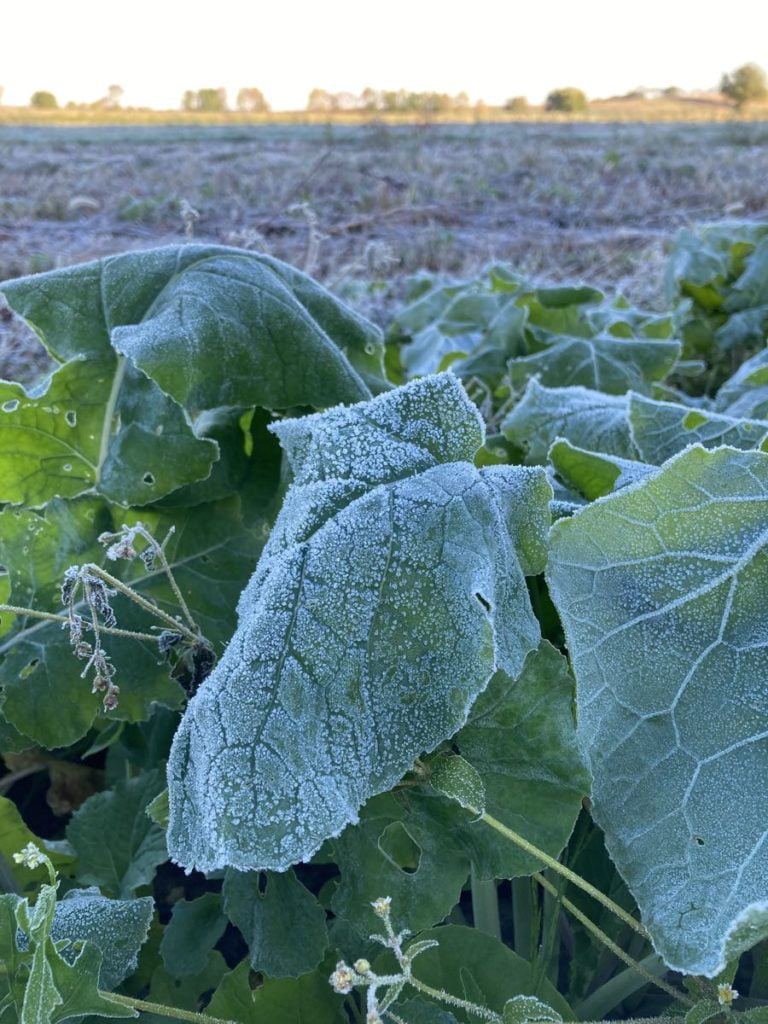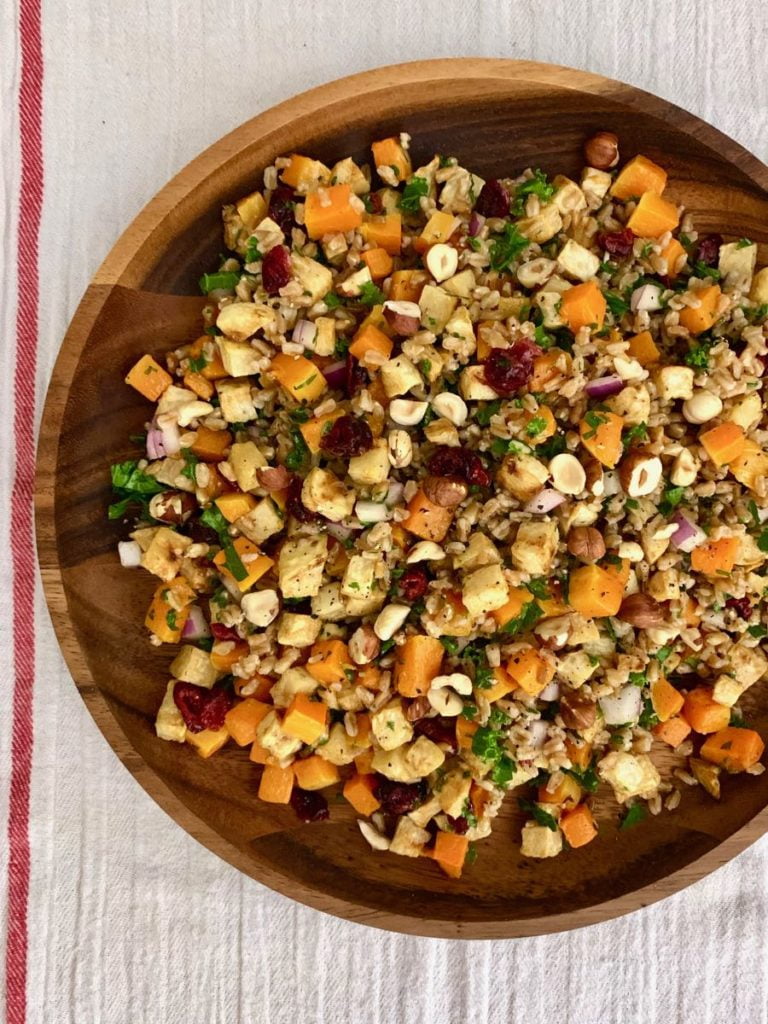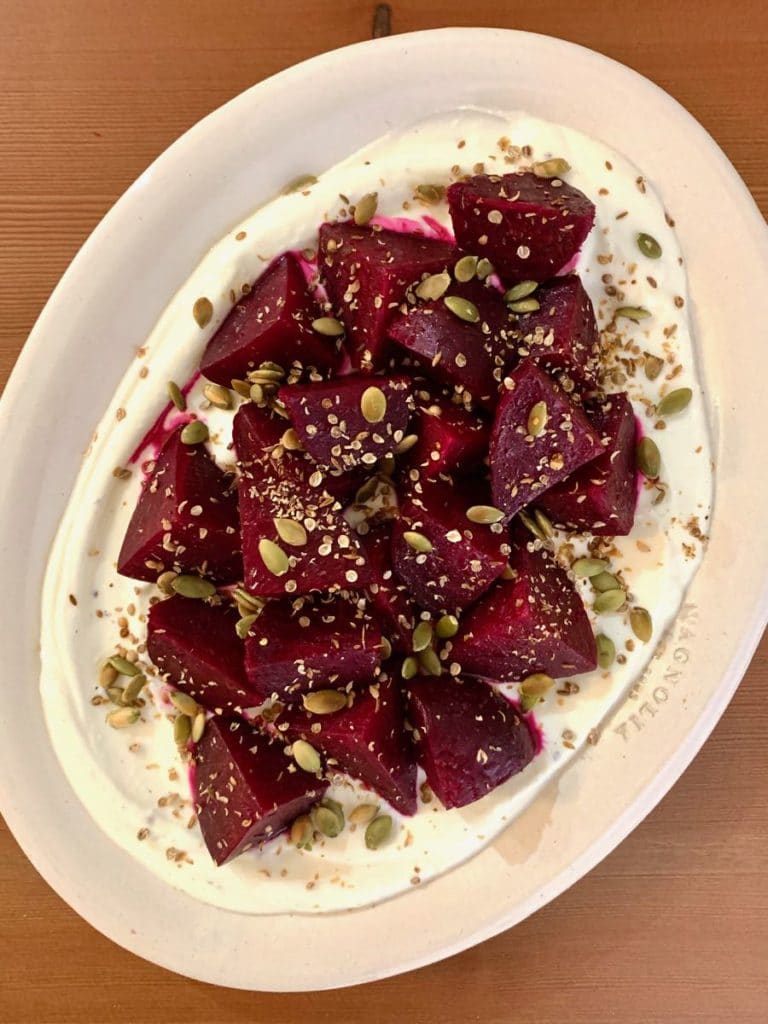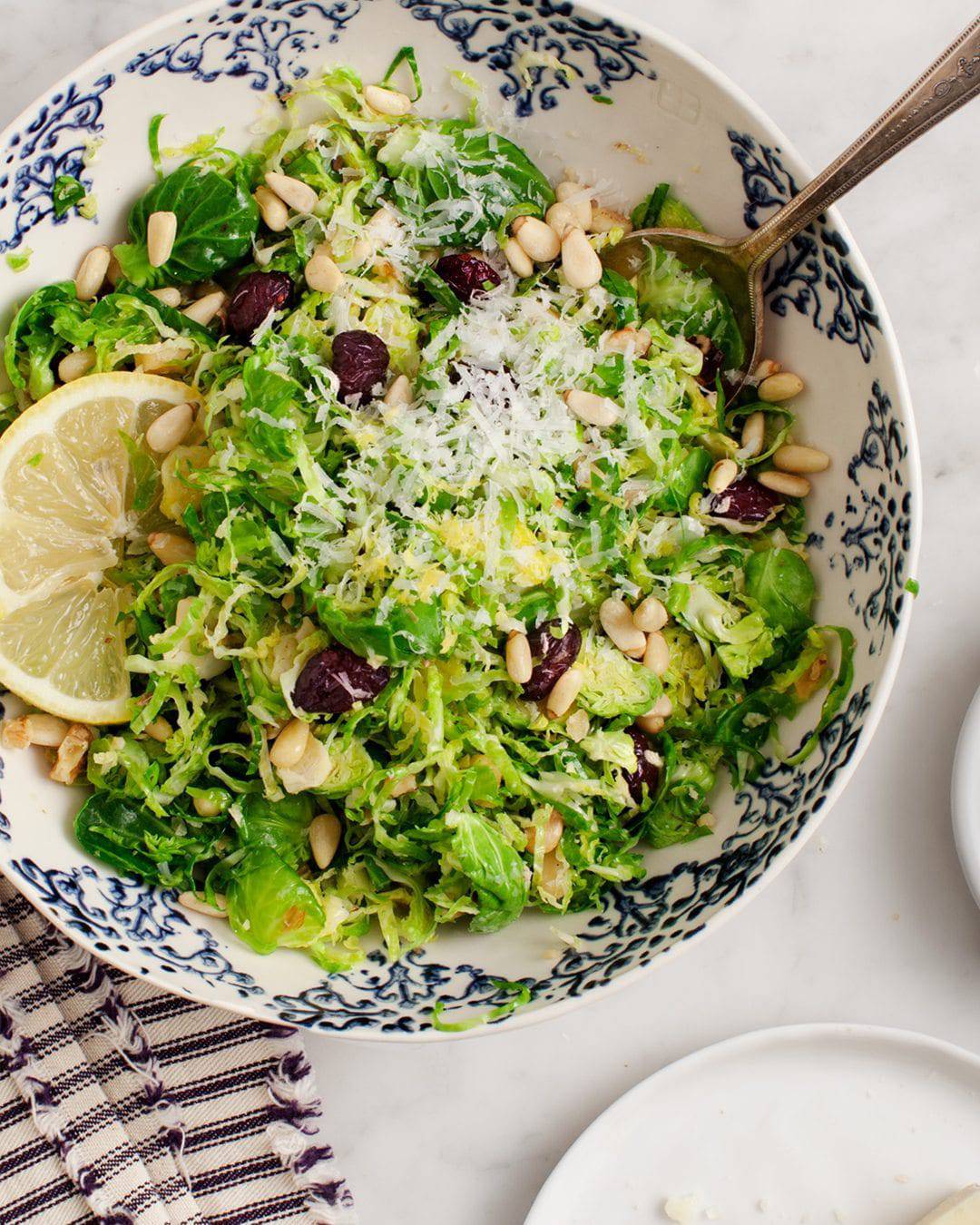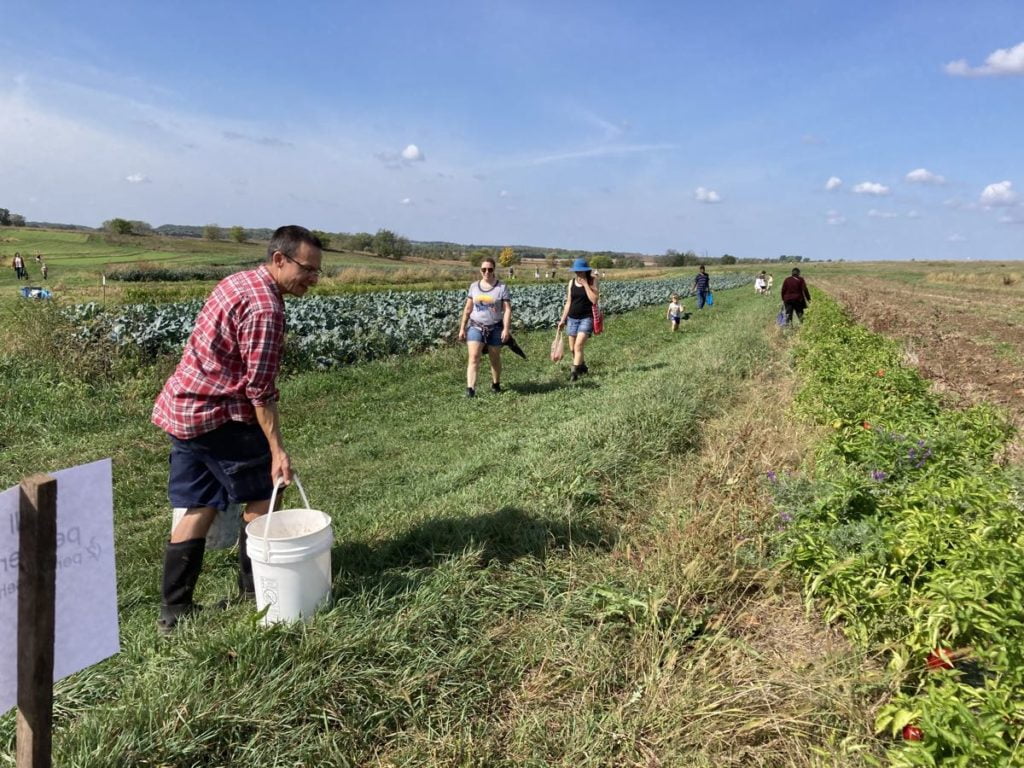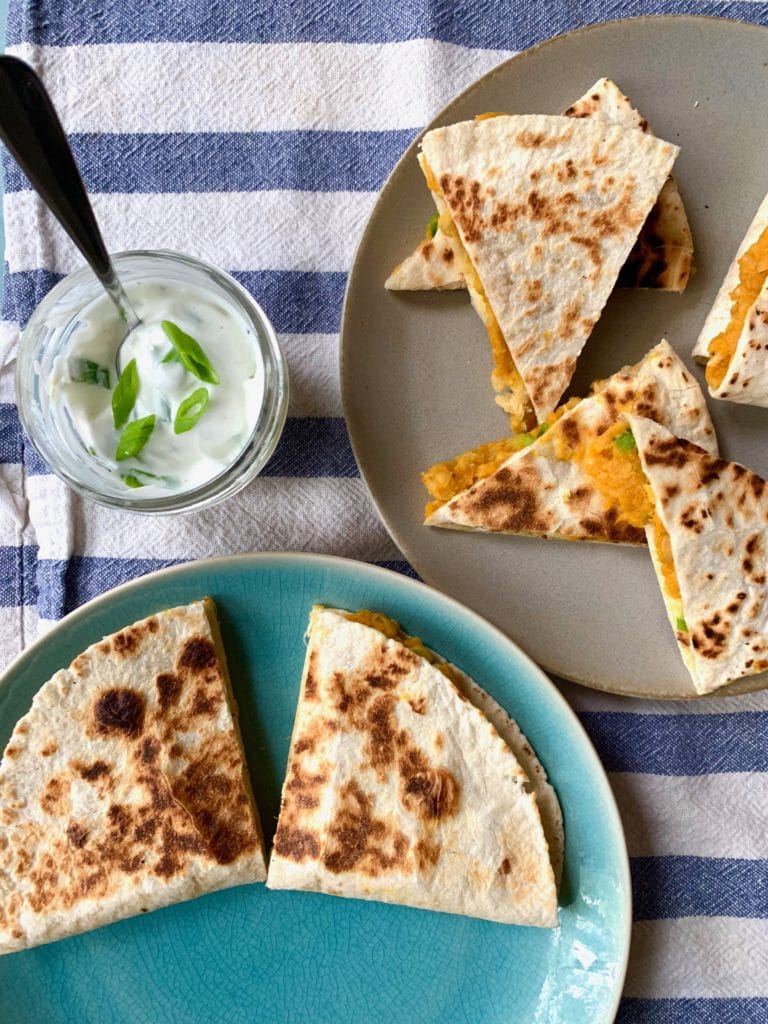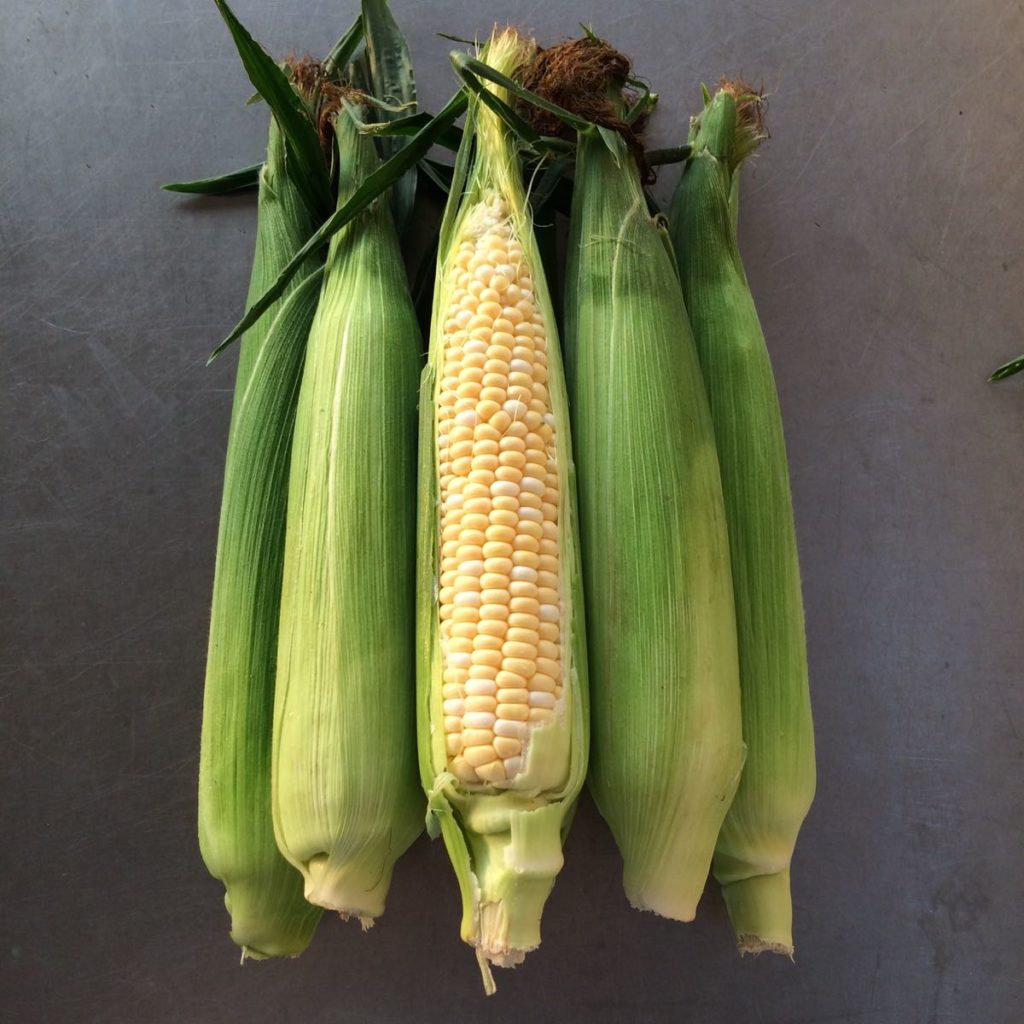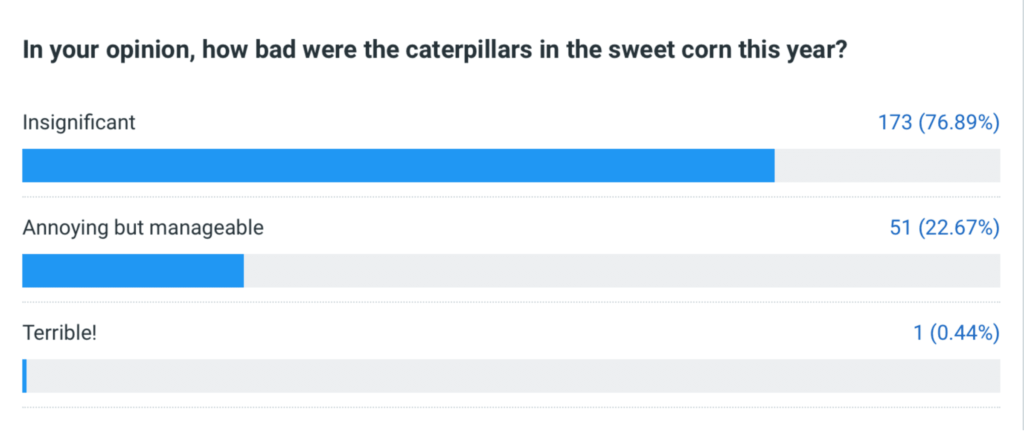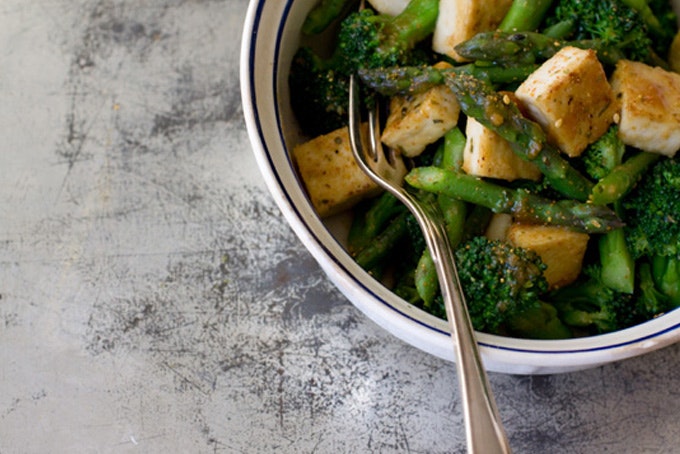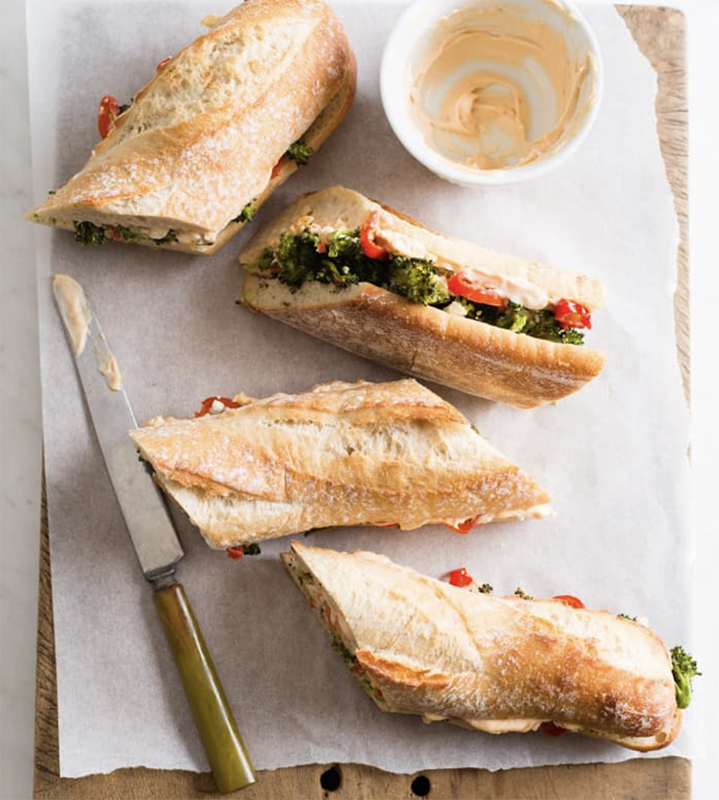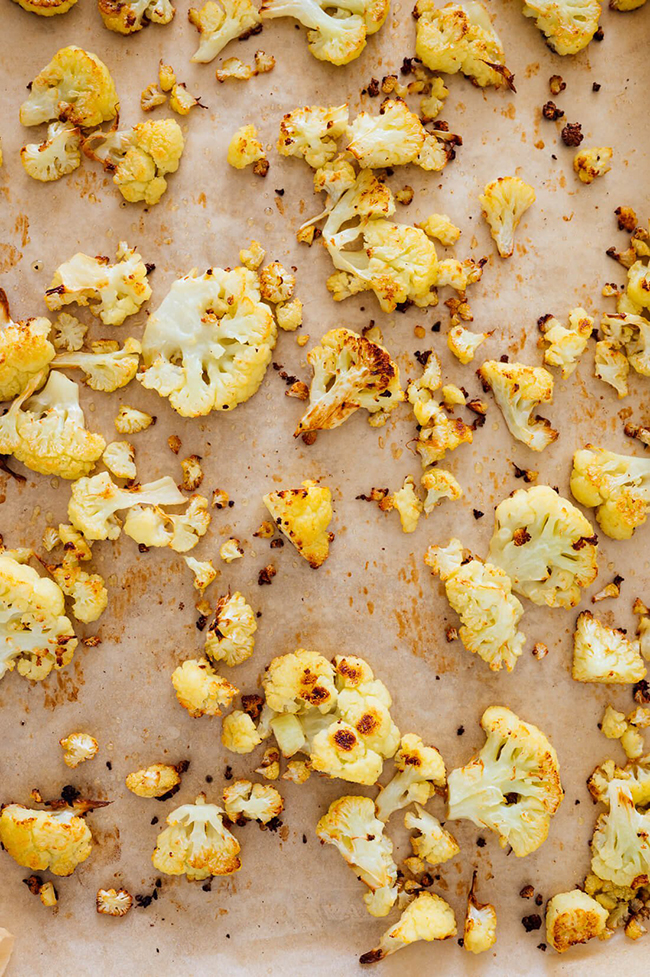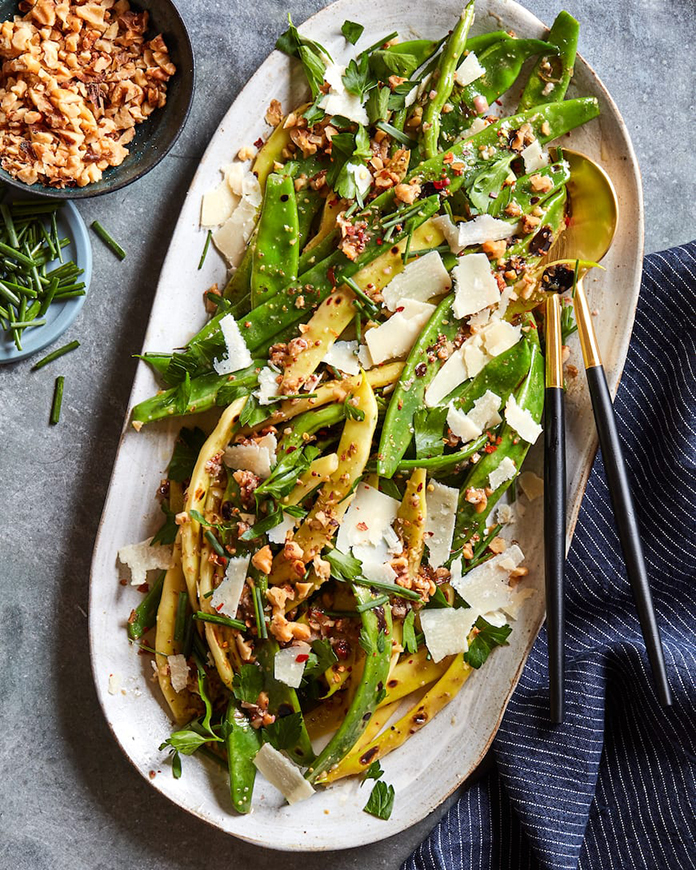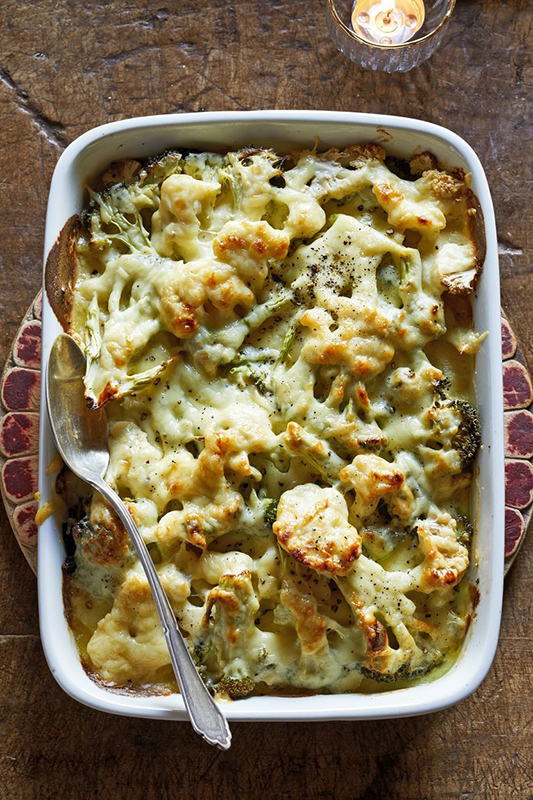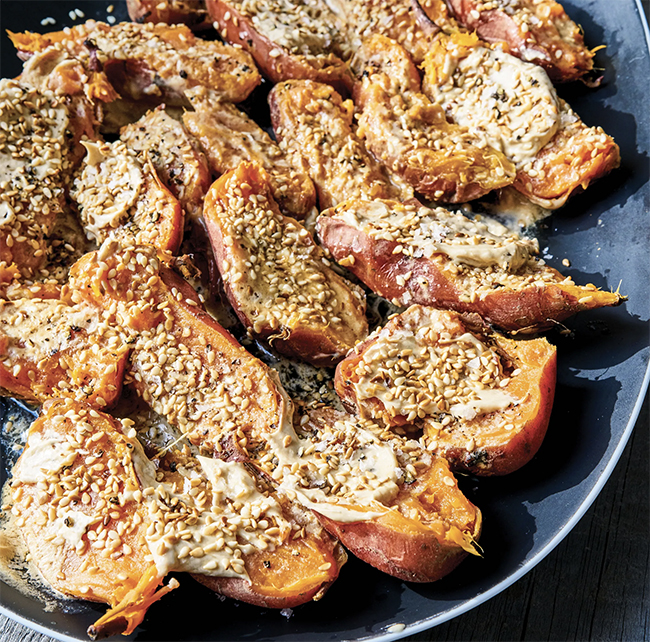Monthly Archives: October 2021
Week #24; Final week of the regular season
- On: October 27, 2021
 0
0

My ‘garlic office’ upstairs in the barn is a warm and peaceful place to sort garlic.

Kale harvest on a blue-sky day. Photo credit Matt Salbego
Season’s end
This is the final delivery of our May – October season. Thank you so much for joining our farm this year. We deeply appreciate the trust you have placed in us. Thank you for letting us feed you. We hope you discovered new favorite dishes, and that we helped you and your friends and family stay healthy and well-fed.
You can expect to hear from us again this fall. We are busy hauling in storage crops and will finish that work by Thanksgiving. Soon, we’ll analyze the season and will get in touch to share our thoughts on the year and will send a survey to gather your thoughts as well.
Have a happy and healthy Thanksgiving.
Love,
Beth & Steve
Veggie List & Veggie Notes
Week #24, October 28/29, 2021
– Weekly shares
– EOW/ green
Brussels sprouts, ~1 lb
‘Orleans’ sweet potatoes, ~3 lb
Butternut squash
Beets, ~2 lb
Celeriac, 1 root
Kale or collards, 1 bunch
A few peppers, mostly ‘suntan’ bells
Poblano chiles (medium heat; in bag with Brussels sprouts), 2
Yellow onion, 1
Red onion, 1
Garlic, 1/2 bulb
– Some sites get broccoli.
– Some sites get cauliflower.
– One site gets Romanesco cauliflower.
Brussels sprouts – Now the sprouts have experienced a few frosty nights, which helps them sweeten a bit. These sprouts have flaws and need a close look. Peel off any bad outer leaves.
Celeriac (knobby, round, bizarre-looking vegetable which smells like celery) – Refrigerate. Celeriac will store in your refrigerator for months. Cut off chunks as you need them. Peel before using. Flavorful celeriac is good raw or cooked. It is excellent in mixed roasted veggies or in soup. It’s especially good in cream soups, alone or mixed with potatoes. Grated raw celeriac is a great starting point for winter salads.
Peppers – Everyone gets a few peppers this week. Most will be ‘suntan’ bell peppers. These are partly ripe; half red and half green. The season is ending so we cannot wait for them to ripen fully!
Garlic – Everyone gets a half bulb of garlic this week. These bulbs dried slowly or had bug issues, so we wanted to open and examine each one. Some of them are a little odd but all are useable.
RECIPES from PHOEBE
Visit our 2020 Recipe Log or our 2019 Recipe Log.
Fall Farro Salad with Cinnamon-Sage Dressing
Filled with sweet, nutty, and savory fall flavors, this hearty salad is a delicious lunch or side dish. It keeps well if you make it ahead of time, but wait to add the hazelnuts until right before you eat.
Serves: 4-6
Prep time: 15 minutes
Cook time: 50 minutes
Ingredients
1/3 cup raw hazelnuts
4 cups peeled and cubed butternut squash (1/2-inch cubes)
4 cups peeled and cubed celeriac (1/2-inch cubes)
1/4 cup extra-virgin olive oil, more for drizzling
3 tablespoons apple cider vinegar
1 garlic clove, grated
1 teaspoon maple syrup
1/2 teaspoon Dijon mustard
1/2 teaspoon ground sage
1/4 teaspoon cinnamon
1/4 teaspoon sea salt, more for sprinkling
Freshly ground black pepper
3 cups cooked farro
1/3 cup dried cranberries
1/3 cup diced red onion
1 kale leaf, finely chopped
- Preheat the oven to 350°F and line 2 large baking sheets with parchment paper. Spread the hazelnuts on one of the baking sheets and toast in the oven for 7-10 minutes, or until fragrant. Remove from the oven and transfer to a small bowl. Set aside to cool.
- Raise the oven temperature to 425°F. Place the butternut squash on one baking sheet and the celeriac on the other. Drizzle generously with olive oil and sprinkle with salt and pepper. Toss to coat, then spread in an even layer on the baking sheets. Transfer to the oven and roast for 30-40 minutes, or until fork-tender and lightly browned around the edges, tossing halfway.
- Meanwhile, make the dressing. In a small bowl, place the olive oil, vinegar, garlic, maple syrup, mustard, sage, cinnamon, and 1/4 teaspoon sea salt. Add a few grinds of fresh black pepper and whisk to thoroughly combine. Set aside.
- When the hazelnuts are cool to the touch, use your hands to rub off any loose skins. Roughly chop the nuts, then place in a large bowl with the farro, dried cranberries, onion, kale, and roasted vegetables. Toss to combine, then pour in the dressing and toss again. Season to taste and serve.
Roasted Beets with Cumin, Coriander, and Whipped Feta Yogurt
In this recipe, I serve sweet, earthy roasted beets over a creamy, tangy whipped feta yogurt. Toasted pepitas add crunch, and aromatic cumin and coriander seeds take it all over the top! If you want to get ahead here, you can roast the beets and prepare the yogurt up to 2 days in advance. Store them separately until you’re ready to serve.
Serves: 3-4
Prep time: 30 minutes
Cook time: 1 hour
Ingredients
3 medium beets
1 tablespoon pepitas
1 teaspoon coriander seeds
Heaping 1/4 teaspoon cumin seeds
1 garlic clove
1 cup whole milk Greek yogurt
1/2 cup crumbled feta cheese
1 1/2 tablespoons extra-virgin olive oil, divided, more for drizzling
1 1/2 tablespoons fresh lemon juice, divided
1/4 teaspoon sea salt, more for sprinkling
- Preheat the oven to 425°F. Wash the beets well and wrap each one in a sheet of aluminum foil with a drizzle of olive oil and a sprinkle of salt. Place on a baking sheet and roast for 45-60 minutes, or until easily pierced with a fork. Unwrap the foil and set the beets aside to cool.
- Meanwhile, place a small, dry skillet over medium-low heat and add the pepitas. Toast, stirring often, until fragrant and golden brown, 2-3 minutes. Transfer the pepitas to a small bowl and add the coriander and cumin seeds to the skillet. Toast, stirring often, until fragrant, 30 seconds-1 minute. Remove from the heat and transfer to a mortar and pestle. Lightly crush the seeds and set aside.
- Make the whipped feta yogurt: Place the garlic in a food processor and process until minced. Add the Greek yogurt, feta, 1 tablespoon of the olive oil, and 1 tablespoon of the lemon juice and process until smooth. Season to taste and set aside.
- When the beets are cool enough to handle, slip off their skins. Chop the beets into large chunks and transfer them to a medium bowl. Add the remaining 1/2 tablespoon olive oil, the remaining 1/2 tablespoon lemon juice, and 1/4 teaspoon sea salt and toss to combine.
- Spread the whipped feta yogurt on the bottom of a large plate or serving platter. Arrange the beets on top, leaving any juices behind in the bowl. Sprinkle with the pepitas and the crushed spices and serve.
Shaved Brussels Sprouts Salad
From Love & Lemons
This simple fall salad is a bright, refreshing side dish! If you don’t have chives on hand, feel free to skip them. The salad is still great without.
.
.
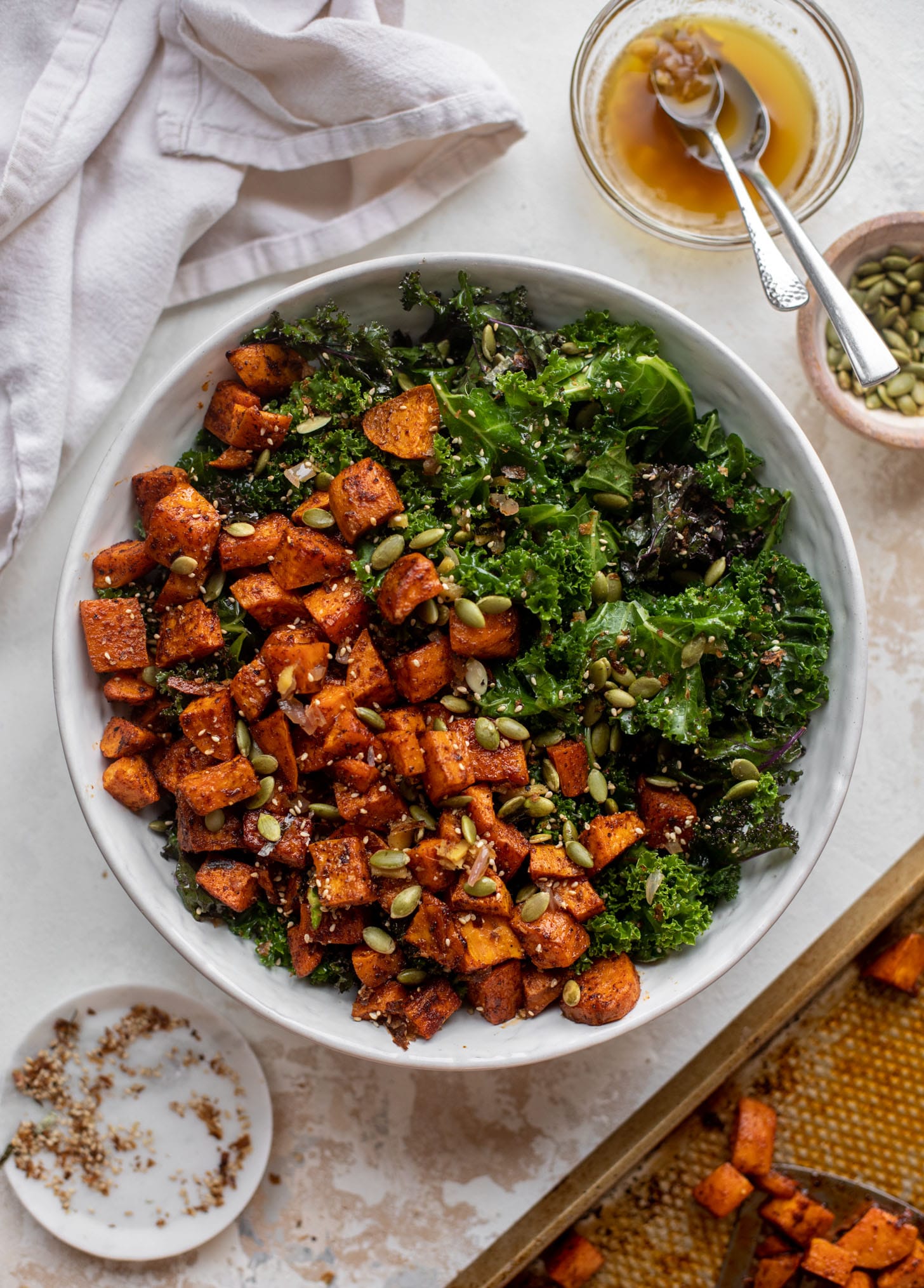
Smoky Sweet Potato Kale Salad with Hot Ginger Dressing
From How Sweet Eats
A perfect lunch salad! It’s made with massaged kale, smoky roasted sweet potatoes, and pepitas for crunch. A tangy, nutty ginger dressing ties it all together.
.
.
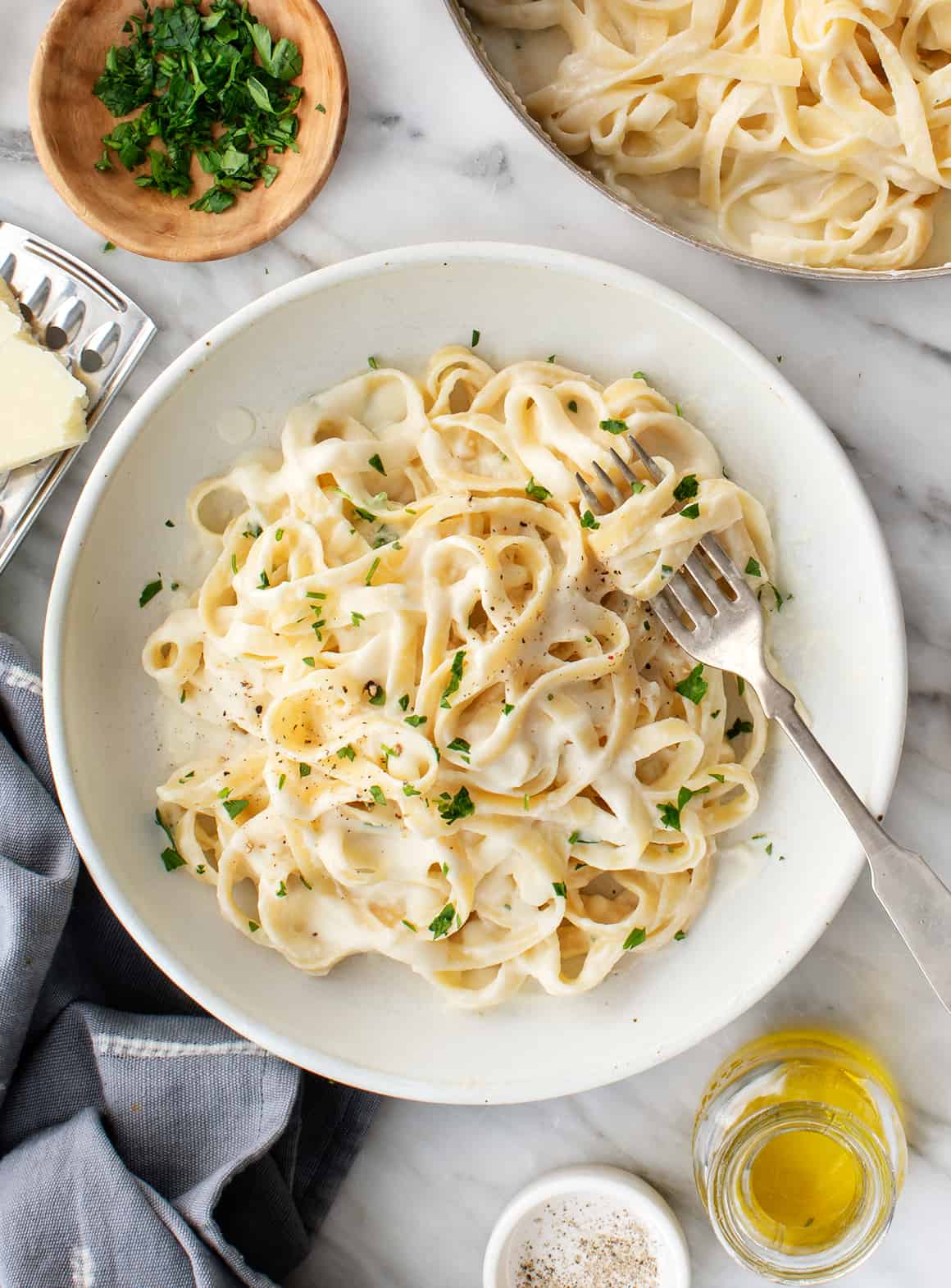
Fettuccine Alfredo
From Love & Lemons
This creamy, comforting pasta has a secret ingredient: cauliflower! For a vegan version, check out this post.
.
.
Garden Keeper’s Pie with Beets, Lentils, and Creamy Celery Root Mash
From The First Mess
This recipe is a perfect match for this week’s box. The filling is a saucy mix of beets, squash, and lentils, and it’s topped with a creamy, savory celery root mash. If you don’t have fresh thyme and rosemary on hand, dried will work just fine.
.
.

Fudgy Vegan Double Chocolate Beet Muffins
From Minimalist Baker
Blended roasted beets make these muffins wonderfully fudgy and moist. Don’t worry, you won’t taste them!
.
.
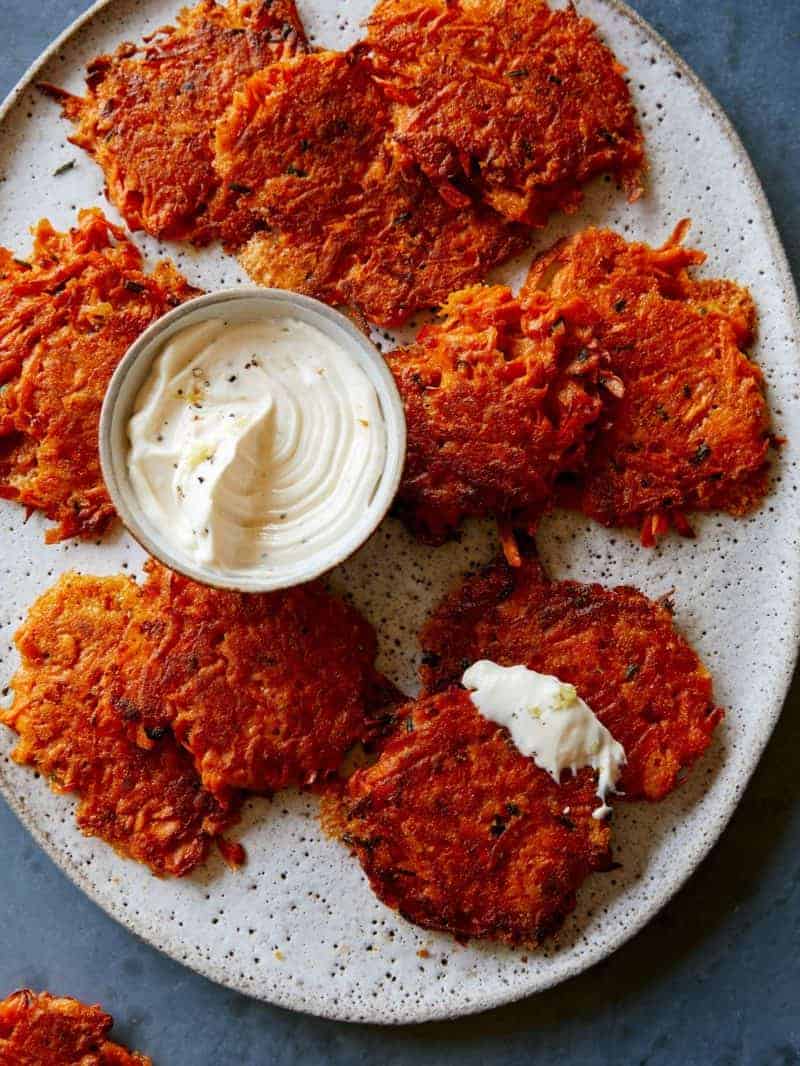
Cheesy Sweet Potato Fritters
From Spoon Fork Bacon
What a fun way to cook sweet potatoes! If you have extras, the recipe’s author, Jenny Park, recommends freezing them and reheating them later in the oven. Feel free to omit the chives if you don’t have any on hand.
Week #23; Season is almost over. Nature surges on.
- On: October 20, 2021
 0
0
It is hard to believe that our regular CSA season is almost over!
Wow, it’s been an excellent growing season. Let’s review our final deliveries:
– This week (Oct 21) is the final delivery for our EOW/purple and Sampler/sun members.
– Deliveries ended two weeks ago for our Sampler/moon group.
– Next week (Oct 28) is the final delivery for Weekly and EOW/green.
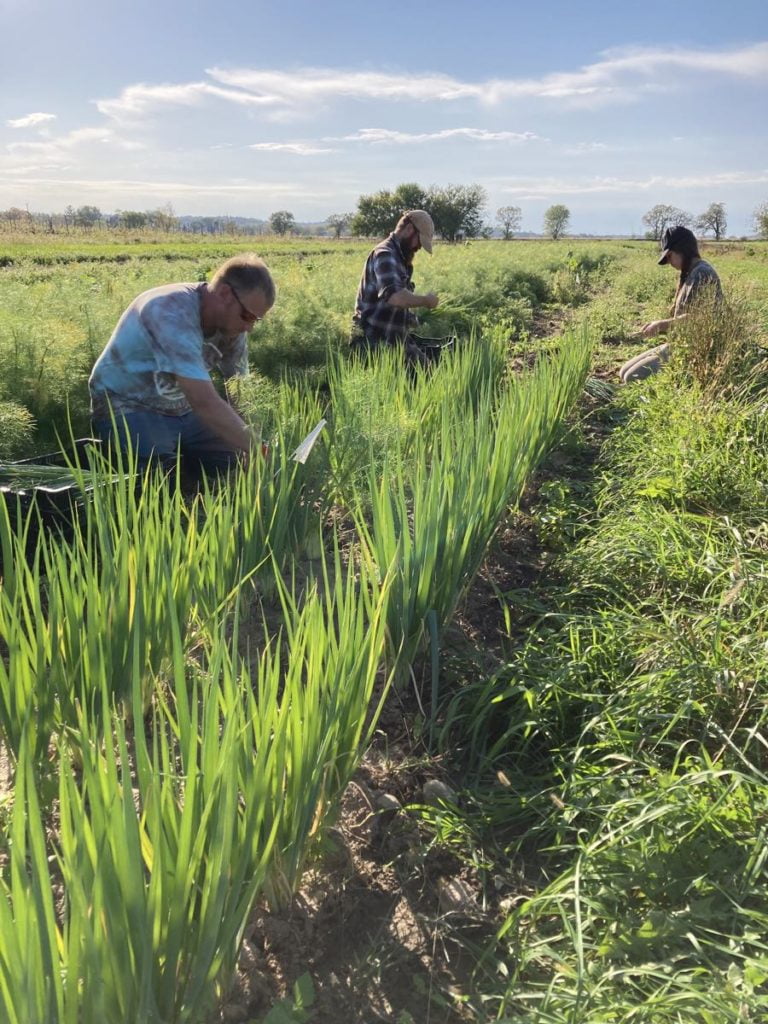
Scallion harvest on a beautiful afternoon.
Nature surges on.
By October 21 in most years, many of our crops are shut down by cold weather and frost. We hurry about to harvest the last peppers or protect them from frost. Not this year! Our fall crops continue to absorb the late warmth, and continue to grow. The upsides of a warm fall are extra growth and pleasant working conditions. Our fall work is much easier and less stressful in mild weather.
The downside is that some crops need cold nights to trigger maturation. Some cauliflower and Romanesco broccoli varieties behave that way, and have not formed their heads yet. Other crops like Brussels sprouts and parsnips improve in quality after repeated frosts. We couldn’t wait any longer, so we’re sending both of those vegetables this week. They’re still good, just less sweet.
Obviously, the biggest downside is concern that we’re experiencing the effects of global warming.
Beth
Veggie List & Veggie Notes
Week #23
– Weekly shares
– EOW/ purple
– Sampler/ sun
Brussels sprouts, 1 lb
Parsnips, ~1.5 lb
Satina potatoes, 3.5 lb
Leeks, ~2 count
Koji greens
Poblano chiles (in Brussels sprouts bag), 2
Frying or bell peppers, 3 – 4
Scallions, 1 bunch
Shallots, 1 or 2
– Most sites get broccoli.
– A few sites get cauliflower.
– A few sites get Jester winter squash OR sweet potatoes.
Next week’s box will probably contain Brussels sprouts, butternut squash, sweet potatoes, celeriac, beets and more.
Brussels sprouts – If you are a new CSA member, please approach Brussels sprouts with an open mind. Many of us grew up eating awful, overcooked Brussels sprouts. These Brussels sprouts are completely different.
This week’s sprouts – These have flaws and need a close look. Peel off any bad outer leaves.
Here is our method to cook Brussels sprouts: Wash the sprouts and trim the cut ends. Cut an X in the stem end of large sprouts. Cut a single slit in small or medium sprouts. This does two things. It helps the Brussels sprouts cook evenly, plus it allows them to soak up any marinade or dressing. Place sprouts in a pot with one inch of water in the bottom and steam until tender, 7 to 10 minutes. If the sprouts are uneven in size, then set aside the smallest ones and add to the pot after the larger ones have cooked for a few minutes. Don’t overcook them! You can also oven-roast Brussels sprouts.
Here are a few dressing ideas for cooked sprouts:
– Sherry vinegar/olive oil/Dijon mustard/garlic/white wine/salt and pepper. This is our favorite, especially when you combine the Brussels sprouts with slivered peppers and thinly sliced onions. Delicious warm, cold, or at room temperature.
– Balsamic vinegar/olive oil/garlic/salt and pepper
– Lemon juice and zest/melted brown butter/poppy seeds/white wine/garlic/salt
Parsnips (These look like large white carrots) – Those long, white roots are not carrots, they are parsnips. The two vegetables are related. When cooked, parsnips are sweet and starchy. For the best flavor, brown them to caramelize the sugars. Here are a few ideas for parsnip preparation:
– Caramelize the parsnips by roasting them in a vegetable medley.
– Parsnip fries are delicious: cut like French fries, oil lightly, place on a cookie sheet and roast in a hot oven until brown and cooked through.
– Try substituting grated parsnips in a potato pancake recipe. They brown beautifully and are very tasty.
– Steve loves pan-fried parsnips with onions and garlic.
Satina yellow potatoes – These are from our friends Brad and Brian Igl’s farm near Antigo. Store dry at room temperature, in the paper bag to protect from light. These are good all-purpose potatoes. They roast very nicely.
Leeks (look like big scallions) – These alliums have a milder flavor than onions. Nonetheless, they can be used in recipes that call for onions. To wash, split the leek lengthwise, from the green tops about halfway to the base, leaving the base intact. Rinse well under running water, separating the layers to flush. If necessary, split the leek further if soil has penetrated more than halfway down the leek. Shake dry. Leeks are generally eaten cooked. They can be sauteed, steamed or roasted. Intact leeks will store 2 to 3 weeks if covered loosely and refrigerated. The outer leaves will yellow. Just peel them off and discard. The inner leek layers will be fine.
Koji greens (head of dark green leaves) – Refrigerate.
Koji greens are a lot like Yukina if you know that one; dark green with a nice balance of bitter flavor but not too strong. Like tat soi but with larger, lusher leaves and not so many leaf stalks. Recipes that use mustard greens or bok choy will work with Koji. In a contest for my favorite fall green, Koji runs neck and neck with bok choy.
Poblano chiles (in bag with Brussels sprouts) – Dark green or red, triangular. These have medium heat and terrific flavor. We’ve included them with the potatoes and leeks because they are such a great combination. Roast your poblanos, then use to top any soup or casserole you prepare with your potatoes.
Shallots (look like small red onions) – Store at room temperature. Shallots store for a long time. Excellent minced for salad dressing. They will sweeten considerably when fried and can be used in Thai or Vietnamese dishes, to top burgers, etc.
Fried shallots – Thinly slice shallots. Heat 2 Tbsp peanut oil in a small skillet over medium-low heat. Add shallots and fry gently, mixing occasionally, until golden brown.
RECIPES from DEB
Visit our 2020 Recipe Log or our 2019 Recipe Log.
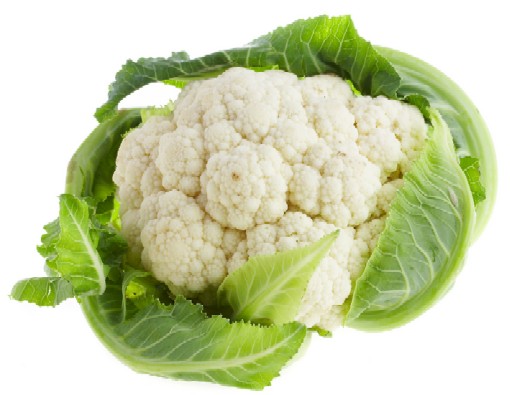
Cauliflower and garbanzo bean curry
Based on a recipe by Hugh Fearnley-Whittingstall of River Cottage, I, like everyone else in the comments, do not make it exactly as written. This recipe is vegan, as long as you don’t serve it with yogurt!
Serves 4-6
Takes 30 minutes, plus about 15 minutes extra cooking time if you use brown rice
1 1/2 cups raw white or brown rice
pinch of salt
2 tablespoons vegetable oil
2 cups chopped onions
1-2 poblano chiles, chopped
2-3 garlic cloves, minced or put through a press
1 1-inch piece of fresh ginger, grated
2 teaspoons ground coriander
2 teaspoons ground cumin
2-3 teaspoons garam masala or yoru favorite curry powder (I like Penzey’s sweet curry)
Salt and freshly ground black pepper to taste
1 head of cauliflower (1 1/2-1 3/4 lbs.), cut into bite-size florets
1 cup chopped tomatoes, canned or fresh
About a cup (half a can)of coconut milk, or veggie broth
1 (14-ounce) can garbanzo beans, drained and rinsed
3-4 scallions, thinly sliced
Start cooking the rice – in a saucepan with a lid, combine the rice with 2 3/4 to 3 cups cold water (the smaller amount is for white rice). Bring to a boil uncovered, then add salt, cover, and turn the heat to the lowest setting. Cook about 15 minutes for white rice, and 45 minutes for brown.
Heat the oil in a deep wide skillet with a lid, over medium heat. Add the onions, garlic, and ginger and sauté for about 10 minutes, stirring often. Add the coriander, cumin, chile flakes, garam masala or curry powder, and some salt and pepper and cook for a few more minutes. Add the cauliflower, the tomatoes with their juice, and the chickpeas, and stir well. Pour in enough coconut milk or veggie broth to cover everything, and bring to a simmer. Cover and cook for 10-15 minutes, stirring once or twice, until the cauliflower is tender. Check the seasoning, and add the scallions. Serve with plain or Greek yogurt, chutney, and naan.
.
.
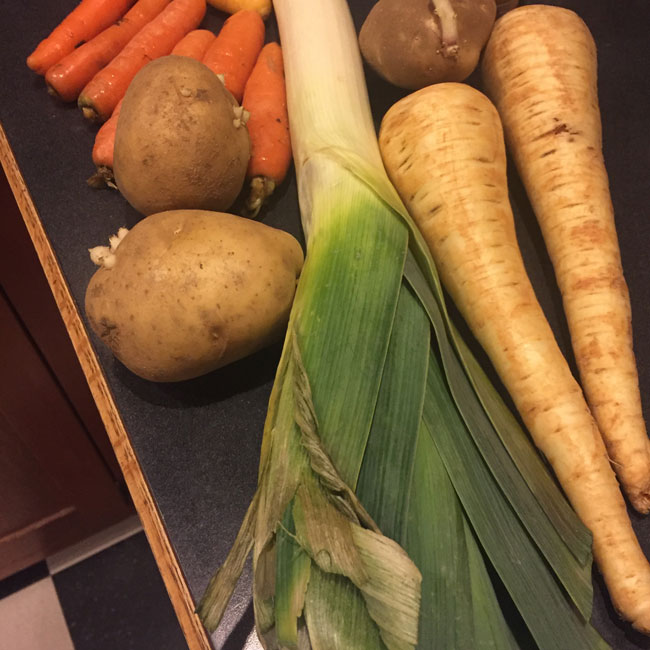
Nearing the end of the CSA potato soup
I developed this soup a few years ago, deep in the winter, to use up almost the last veggies from my Tipi storage share, what my family calls our “Thanksgiving Box”, but it adapts nicely for this week’s box. You can adjust the vegetables depending on what you’ve got – you need 4-5 cups of vegetables, so use more potatoes if you don’t have any carrots; a few of this week’s red peppers would add really nice color; use more leeks!
Serves 4-6
Takes about an hour, about 30 minutes active work, and the rest simmering
Ingredients:
1-2 tablespoons olive or vegetable oil
white and pale green parts of 1-2 leeks, split length-wise, well rinsed and sliced – one generous cup
2 parsnips, peeled, woody parts removed, and chopped – 3/4 cup
3 medium potatoes, peeled and chopped into 1 to 1 1/2 inch cubes – a generous cup, maybe a cup & a third
2/3 cup peeled and chopped carrots
3-4 cups veggie or chicken broth, home made if you’ve got it, but you can use soup base and water, or even plain water
2 tablespoons butter, or vegan butter
1/4 cup flour
2 cups milk, half & half, or a mixture (I half half & half and half 2% milk – that’s a lot of halfs) – or more veggie broth to make a non-dairy soup
kosher salt and freshly ground black pepper.
Pour the olive oil into a large pot that holds at least 4 quarts, and heat till fragrant. Add the leeks and some salt and pepper, give them a stir, and let them cook gently over medium heat while you chop up the rest of the vegetables. Add the parsnips, potatoes, and carrots, and continue to cook over medium heat until softened and starting to brown. They might start sticking a little bit, don’t worry about that – they’ll come loose when you add the broth.
Add the broth, making sure you have enough to cover all the vegetables – add water if necessary. Raise the heat until the mixture comes to a boil, then reduce the heat and cover and simmer until all the vegetables are soft, probably 15 minutes. In my experience the carrots take the longest, oddly.
Make the roux while the vegetables cook: melt the butter in a small skillet. Add the flour, and cook and stir for a few minutes until there’s no raw flour smell.
When the vegetables are all cooked, stir in the (cooled) roux, and keep stirring while the mixture thickens, to ensure there won’t be any lumps. Mix the half & half and milk in a spouted glass measuring cup, heat it to just slightly warm in the microwave, and add it to the soup. Heat gently, try not to boil it after you’ve added the dairy, add more salt and pepper, and serve.
.
.
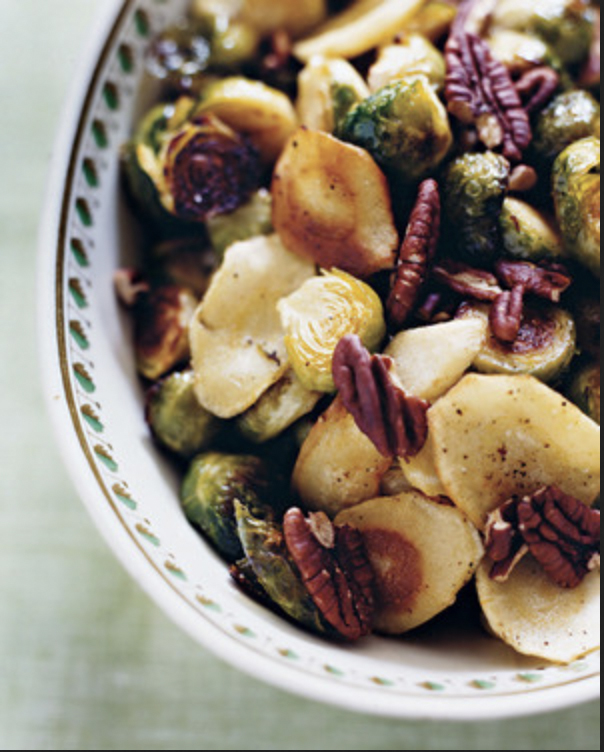
Brussels Sprouts with Parsnips
From Martha Stewart
I made this for Thanksgiving one year, and in all the excitement and people in the house, forgot about the dish, and got a really nice char on all the veggies – it was nevertheless completely eaten. Feel free to omit the pecans.
Takes about 40 minutes
Martha says serves 10, I’d say more like 6, unless it is part of a large meal with lots of other dishes.
.
.

Photo by Ditte Isager
Poblano Potato Gratin
From Epicurious.
This spin on potatoes au gratin was created by Lillian Chou for Epicurious, and every time I make it, people gobble it up. We do not have quite enough poblanos to make the rajas (roasted pepper and onion strips) but you can sub in the red frying peppers from this weeks box.
.
.
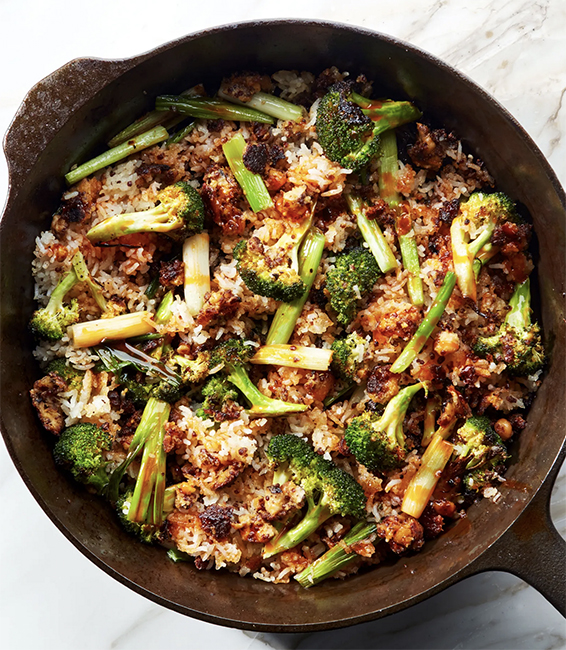
Photo by Joseph De Leo
Julia Turshen’s Favorite Affordable Dinner: Vegetable Fried Rice
From Epicurious.
Use Julia Turshen’s (author of the cookbooks Small Victories, Now & Again, and Feed the Resistance) formula for fried rice to use up lots of the veggies and scallions in this week’s box – cook some extra rice when you make the cauliflower curry and your set! Another delicious variant is kimchi fried rice, if you made some kimchi earlier in the summer – for 2 cups cups rice, use 1 cup of drained kimchi, 4-6 strips of bacon, and all the scallions.
.
.

Pepper and Egg Sandwich
From Leite’s Culinaria.
Here’s recipe for a popular Italian-American sandwich, good for breakfast, lunch, or dinner, that you can make with the red and Poblano peppers from this week’s box. You might want to cut back on the hot sauce since the Poblanos will provide some heat, and sturdy brat buns are a good stand-in for Italian bread.
.
.

Photo by Mark Weinberg
Garlicky Chicken Thighs With Scallion and Lime
From NYT Cooking.
If you’re looking for scallion ideas, here’s a parting thought. To round out the meal, accompany this recipe by Alison Roman with sauteed koji greens and rice.
Week #22. Gleaning day.
- On: October 13, 2021
 0
0
The most common question at the gleaning party this weekend was:
Q: “What happened to the pumpkins?”
A: They were ripe and ready six weeks ago! The blossoms set fruit early and then hot weather sped development. They were ready very early, long before we could host a gleaning party. The winter squash ripened around the same time, but we moved the squash into our dry, safe greenhouse to cure. The pumpkins were left on the ground and many rotted. We simply didn’t have a safe place to move them. Fortunately, we had one pumpkin for each visiting household but everyone had to hunt for the good ones.
The weather was spectacular and there were many other crops to glean, so no one seemed to mind.
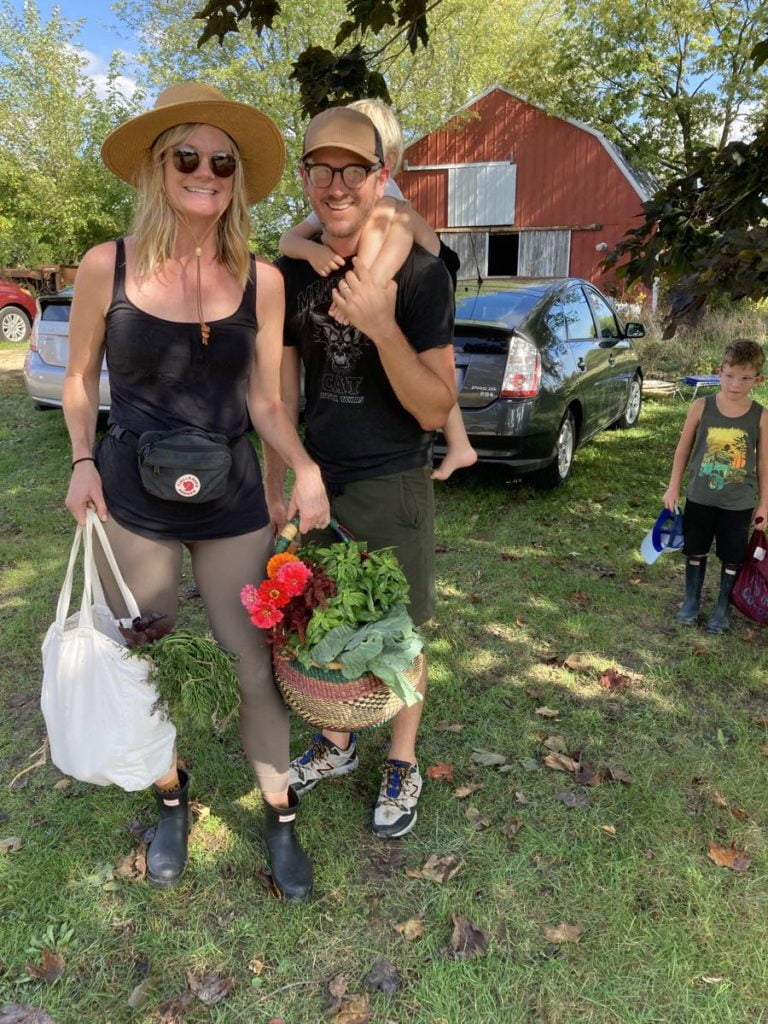
One family’s haul. Everyone pitched in!
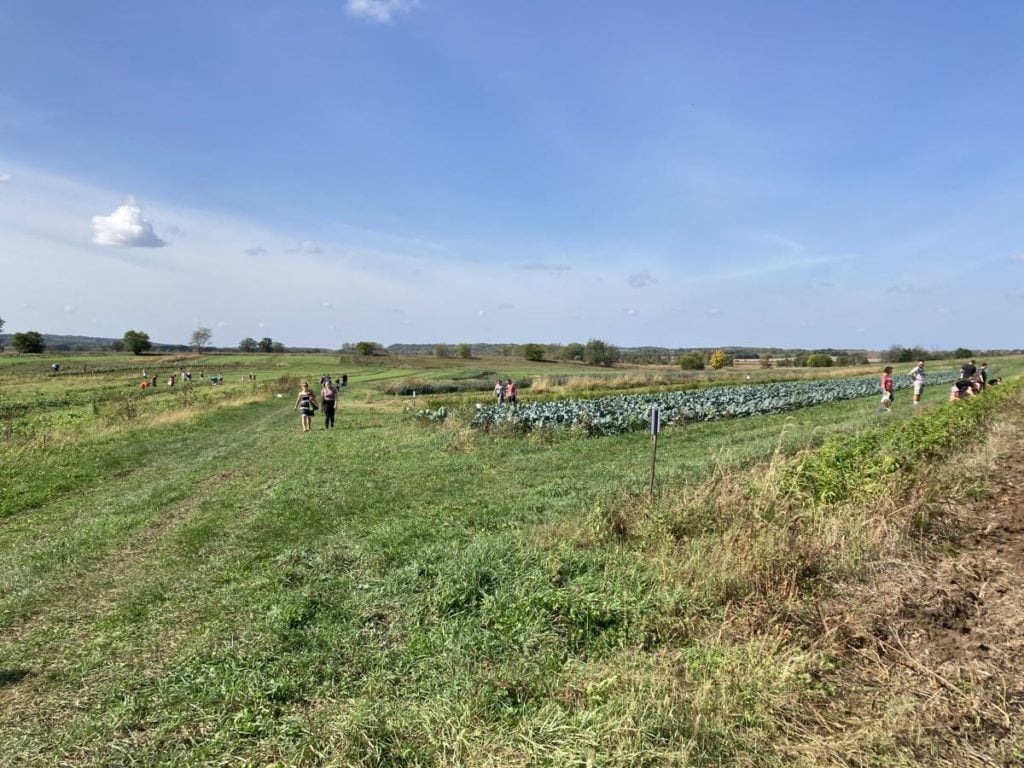
There was plenty of room to spread out. We created the reservation system to manage parking and to moderate how many people arrived at once. Space in the fields isn’t an issue.
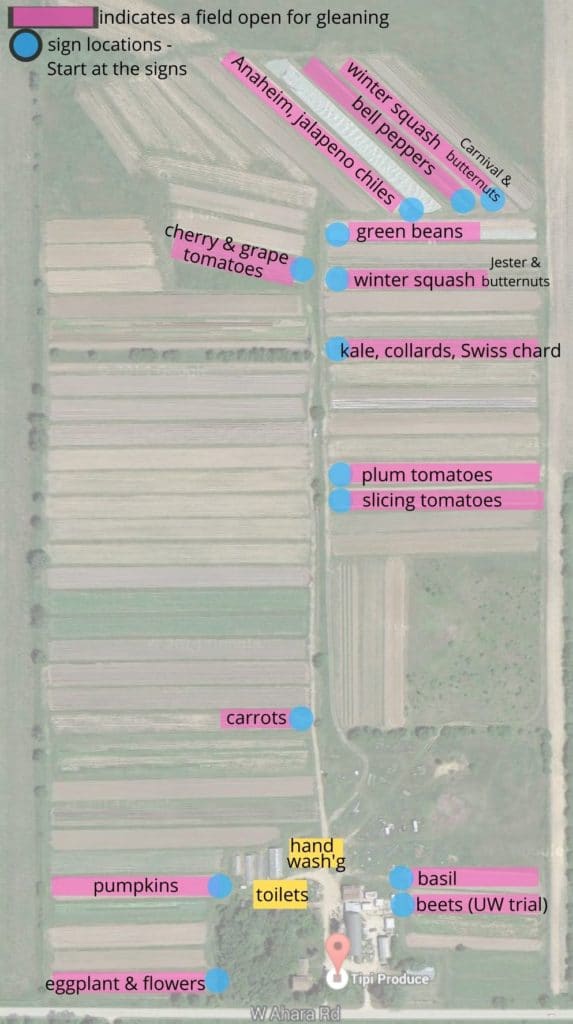
We made everyone hike this year. Many gleaning crops were far from the buildings. It just turned out that way, but meant that members got to see the entire farm this year. It was a perfect day to wander.
Korean radish
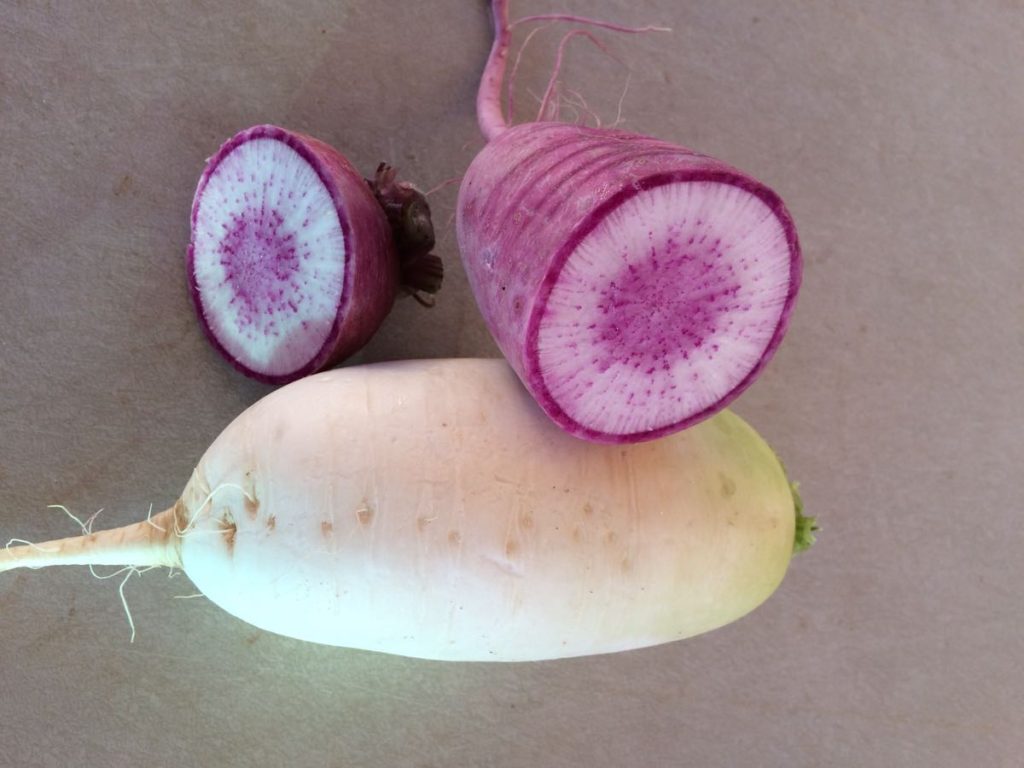
You will receive white and/or purple radish.
This is a favorite vegetable among our farm crew. These crunchy Korean radishes are sweeter and milder than Japanese daikon radishes and come in a more manageable size. They contain lots of water, which makes them easy to pickle or ferment.
Here are some of my favorite uses. You’ll receive about 1.5 lb radish this week (one or two radishes).
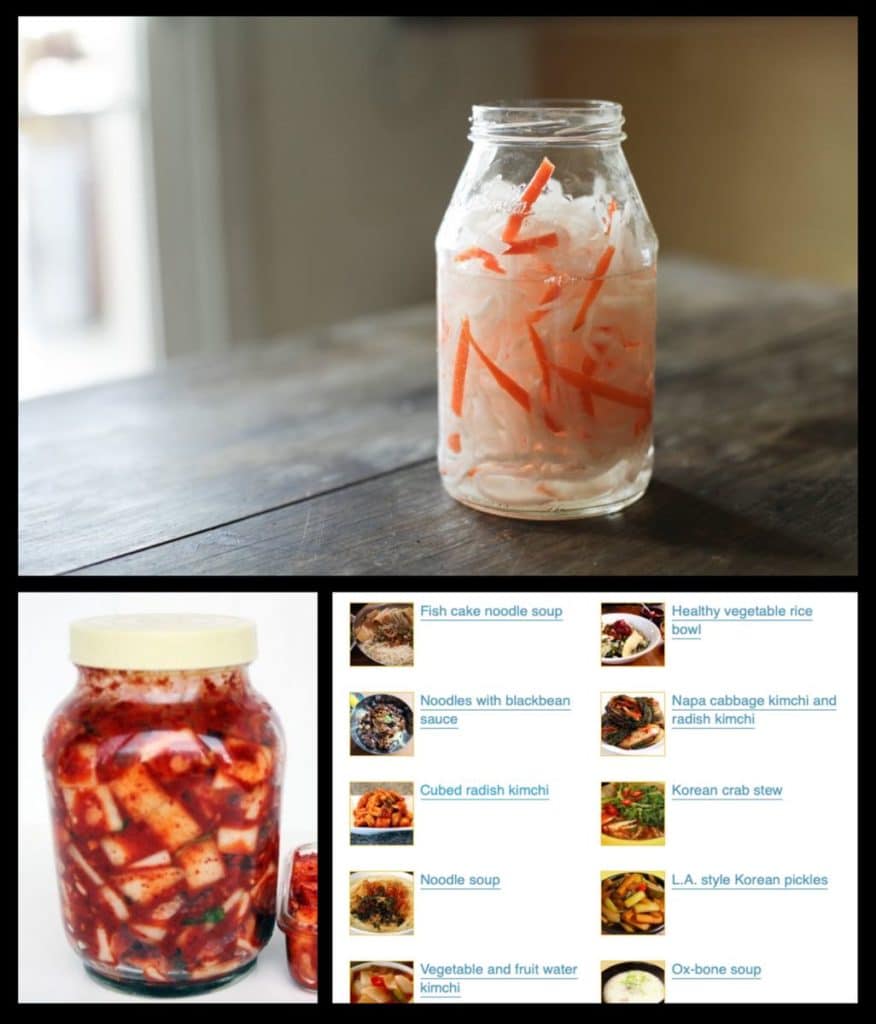
Clockwise from top; Vietnamese Pickled Carrots & Daikon Radish Recipe (Đồ Chua, photo credit Hungry Huy); the Maangchi.com website has so many recipes for Korean daikon including Radish Kimchi (photo credit Maangchi).
Vietnamese Pickled Carrots & Daikon Radish Recipe (Đồ Chua)
From Hungy Huy.
This is my go-to recipe for mixed daikon-carrot salad. The recipe calls for a light fermentation but it’s good after an hour in the fridge. This pickled carrot-daikon salad is used to top bahn mi sandwiches and in other Vietnamese dishes. Huy offers a nice discussion of how this pickle evolved as his family emigrated to the US. He lists these other recipes that the pickles can be used with:
Vietnamese sandwiches (bánh mì), savory crepes (bánh xèo), grilled pork and noodles (bún thịt nướng), egg rolls (chả gìo), and the list goes on. Larger cuts are usually found next to cuts of meat, while finer shreds are put in nước chấm (dipping sauce).
Maangchi rules for radish ideas!
Head to Maangchi for dozens of radish recipes. She has the best website for Korean recipes. Her Radish Kimchi recipe is close to foolproof and easy to scale. If you make kimchi with the radish you receive this week, it should produce about one quart.
The Oriental Food Mart on Park Street in Madison is a Korean grocery that stocks Korean hot pepper flakes called for in many of her recipes. Ask the owner for help picking out your pepper flakes – he is super helpful. I keep a bag of medium heat in our freezer and use them in everything for flavor without excessive heat.
Veggie List & Veggie Notes
Week #22, October 14/15, 2021
– Weekly shares
– EOW/ green
Bok choy
Butternut squash
Romano beans, 1 lb
Carrots, 2 lb
Daikon radish, white OR purple, 1 – 2
Red frying peppers, 5 small
Yellow or red bell pepper, 1
Onion
Scallions, 1 bunch
Jalapeno (HOT)
‘Korean Red’ garlic
– Most sites get broccoli.
– One site gets cauliflower.
Next week’s box will probably contain Koji dark greens, butternut squash, parsnips, leeks, scallions and more.
Butternut squash – Storage: Winter squash store best at room temperature with good air circulation. No cooler than 50 degrees. On your kitchen counter works well. Keep an eye on your squash and cook promptly if any flaws develop. This batch of butternuts should be good for at least one month.
Hint: To make squash easier to cut, microwave on high for 30 to 60 seconds, depending on size of the squash. This will soften the rind and flesh, making it much easier to cut.
Romano beans – These need washing. We got a lot of rain this week. These are pretty mature but might surprise you with their tenderness. They ripened under ideal conditions. I usually recommend braising for beans this mature but we think they are tender enough to use in any fashion.
Frying peppers (red or yellow) – Some are very ripe and have begun to wrinkle. This is not cause for alarm. We call these ‘pepper raisins’. They will be sweet and flavorful.
RECIPES from PHOEBE
Visit our 2020 Recipe Log or our 2019 Recipe Log.
Curried Butternut Squash and Chickpea Quesadillas
Instead of filling these quesadillas with cheese, I stuff them with a yummy mix of roasted butternut squash, chickpeas, and curry spices. A bright scallion yogurt sauce takes them over the top.
Serves: 4-6
Prep time: 20 minutes
Cook time: 1 hour, including roasting the squash
Ingredients
For the scallion yogurt
1/2 cup whole milk Greek yogurt
3 tablespoons thinly sliced scallions
1 teaspoon fresh lemon juice
1/4 teaspoon sea salt
Freshly ground black pepper
For the quesadillas
1 cup roasted butternut squash*
1 1/2 cups cooked chickpeas, drained and rinsed (1 14-ounce can)
1 tablespoon extra-virgin olive oil
1 1/2 teaspoons curry powder
1 teaspoon fresh lemon juice
1/2 teaspoon sea salt
3 tablespoons thinly sliced scallions
2 tablespoons diced jalapeño
Freshly ground black pepper
6 medium flour tortillas
- Make the yogurt sauce: In a small bowl, stir together the yogurt, scallions, lemon juice, salt, and pepper. Season to taste and set aside.
- Prepare the quesadilla filling: In a medium bowl, mash together the squash, chickpeas, olive oil, curry powder, lemon juice, salt, and a few grinds of pepper using a potato masher or the back of a fork. Leave a few whole/larger chickpea pieces for texture. Fold in the scallions and jalapeño and season to taste.
- Assemble the quesadillas: Lay each tortilla flat, and spread the right half with a scant 1/3 cup of the squash filling. Fold each tortilla closed over the filling. Heat a dry nonstick or cast-iron pan over medium heat, and cook each quesadilla for 1-2 minutes per side, or until lightly crisp and golden brown. Remove from the heat, slice, and serve with the scallion yogurt.
*To roast the squash: Preheat the oven to 375°F and line a large baking sheet with parchment paper. Slice a butternut squash in half vertically, scoop out the seeds, and rub the cut sides with olive oil and sea salt. Place cut-side-down on the baking sheet and roast until the squash is very tender, 35-45 minutes. Measure 1 cup of the soft flesh for this recipe (about 1/2 a medium-large squash). Blend the remaining squash into soup or a dip, or use it in baking recipes, like the scones in the newsletter from Week 19.
.
.
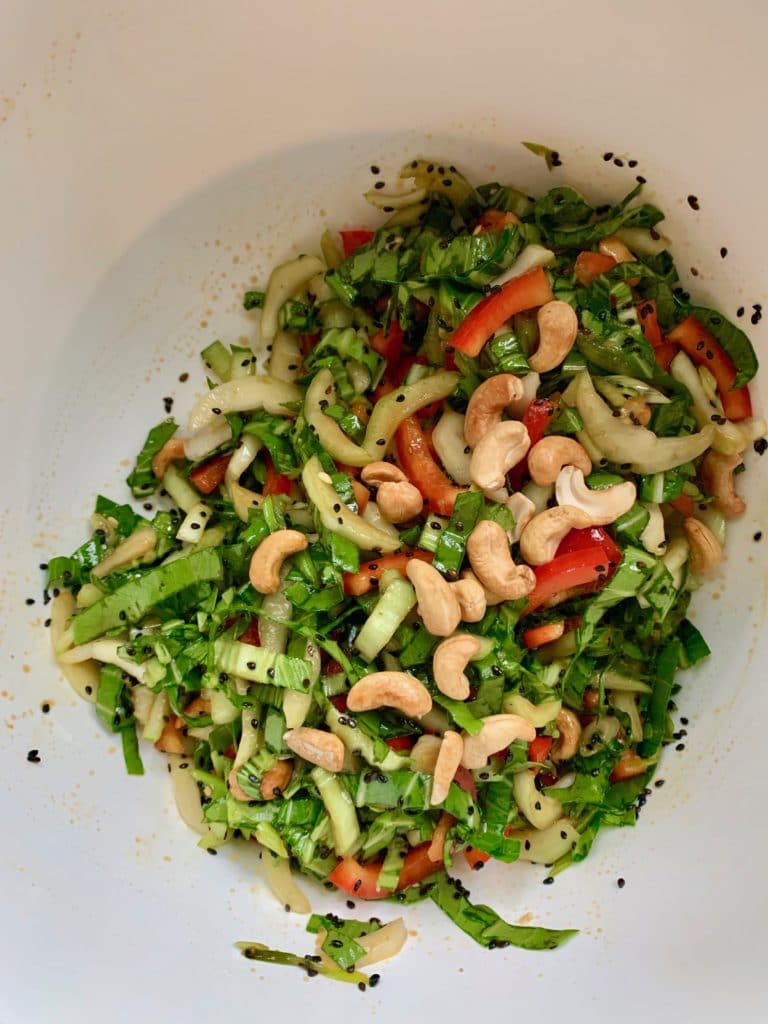
Sesame Bok Choy and Bell Pepper Slaw
This quick slaw is such a fresh, easy side dish. A tangy sesame dressing coats crisp veggies and crunchy toasted nuts.
Serves: 4-6
Prep time: 20 minutes
Cook time: 10 minutes
Ingredients
1/2 cup raw unsalted cashews
2 tablespoons sesame seeds
2 tablespoons extra-virgin olive oil
1 1/2 tablespoons tamari or soy sauce
1 tablespoon toasted sesame oil
1 tablespoon rice vinegar
2 teaspoons maple syrup
1 teaspoon grated fresh ginger
1 large bok choy, stems and leaves thinly sliced
1 colored bell pepper, thinly sliced into 1-inch strips
4 scallions, thinly sliced on the bias
- Preheat the oven to 350°F and line a baking sheet with parchment paper. Spread the cashews and sesame seeds on the baking sheet in a single layer and transfer to the oven. Toast for 8-12 minutes, until the cashews are golden brown and the nuts and seeds are fragrant. Set aside to cool.
- In a small bowl, whisk together the olive oil, tamari, sesame oil, rice vinegar, maple syrup, and ginger.
- In a large bowl, toss together the bok choy, bell pepper, and scallions. Pour on the dressing and toss to coat. Add the toasted cashews and sesame seeds and toss again. Season to taste and serve.
Carrot Ginger Soup
From Love & Lemons
Made with under 10 ingredients, this lightly creamy carrot soup is ridiculously simple and delicious.
.
.

Healthy Carrot Muffins
From Cookie & Kate
These veggie-packed muffins would be a yummy breakfast or afternoon snack.
.
.
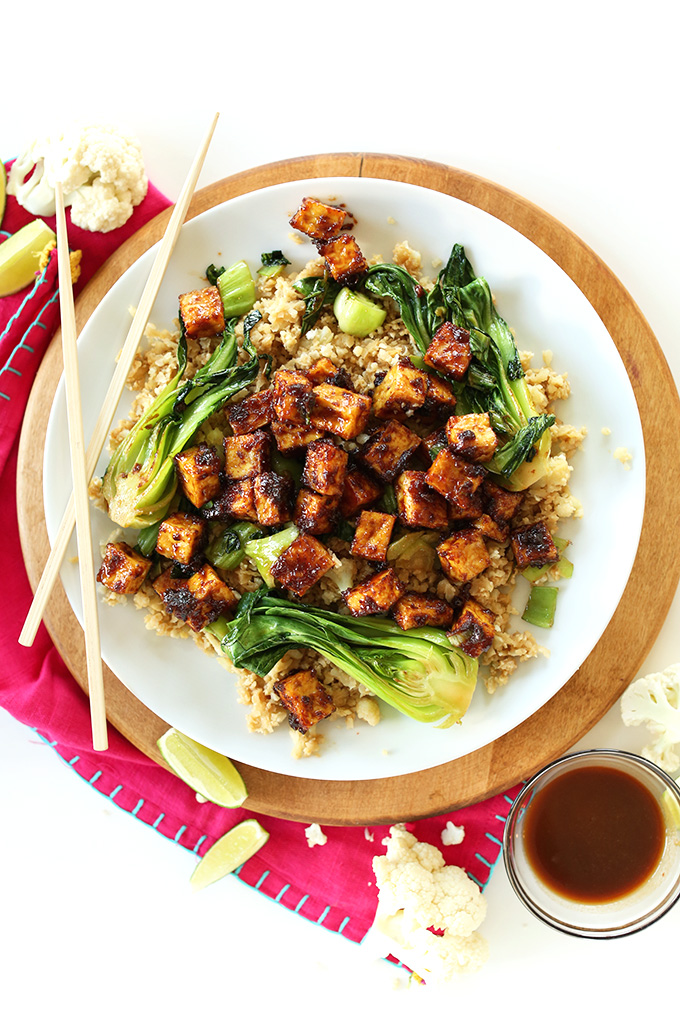
Crispy Peanut Tofu and Cauliflower Rice Stir-Fry
From Minimalist Baker
This stir-fry would be a great way to use your bok choy, green onions, bell pepper, and/or broccoli this week! If you have cauliflower in your box, you could also make the cauliflower rice. If not, the stir-fry would be just as good served over regular rice. A mix of regular rice and cauliflower rice would work well too.
.
.
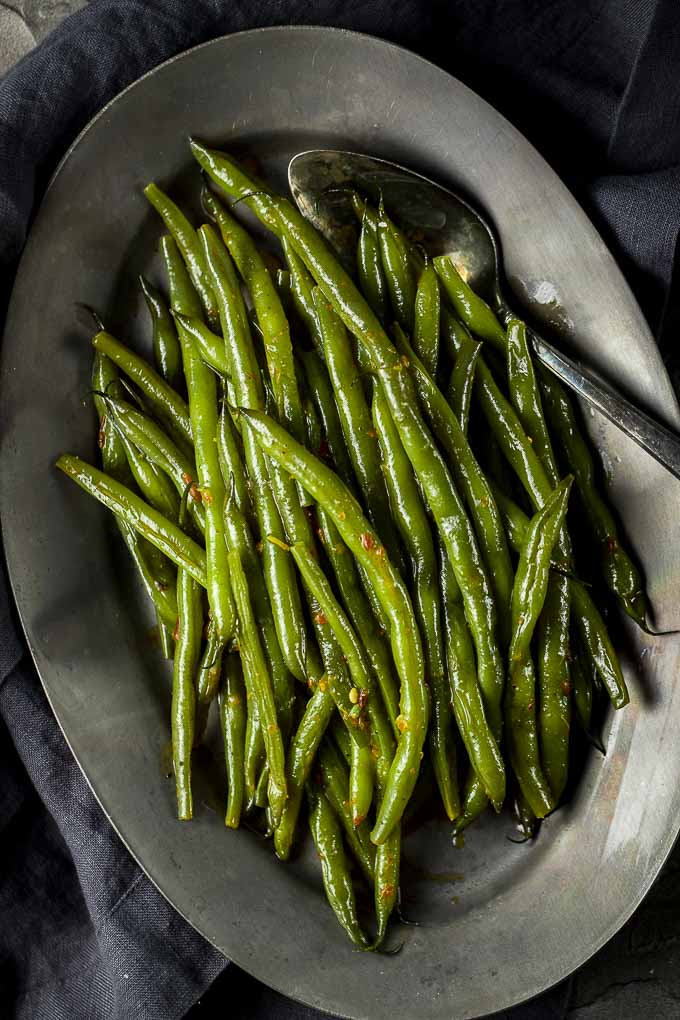
Spicy Braised Green Beans
From Went Here 8 This
This method would be a great way to cook your romano beans this week. Because romano beans are thicker and tougher than regular green beans, you may need to increase the simmering time to 45 minutes or more. If the pan starts to dry out, just add a bit more coconut milk or water.
.
.
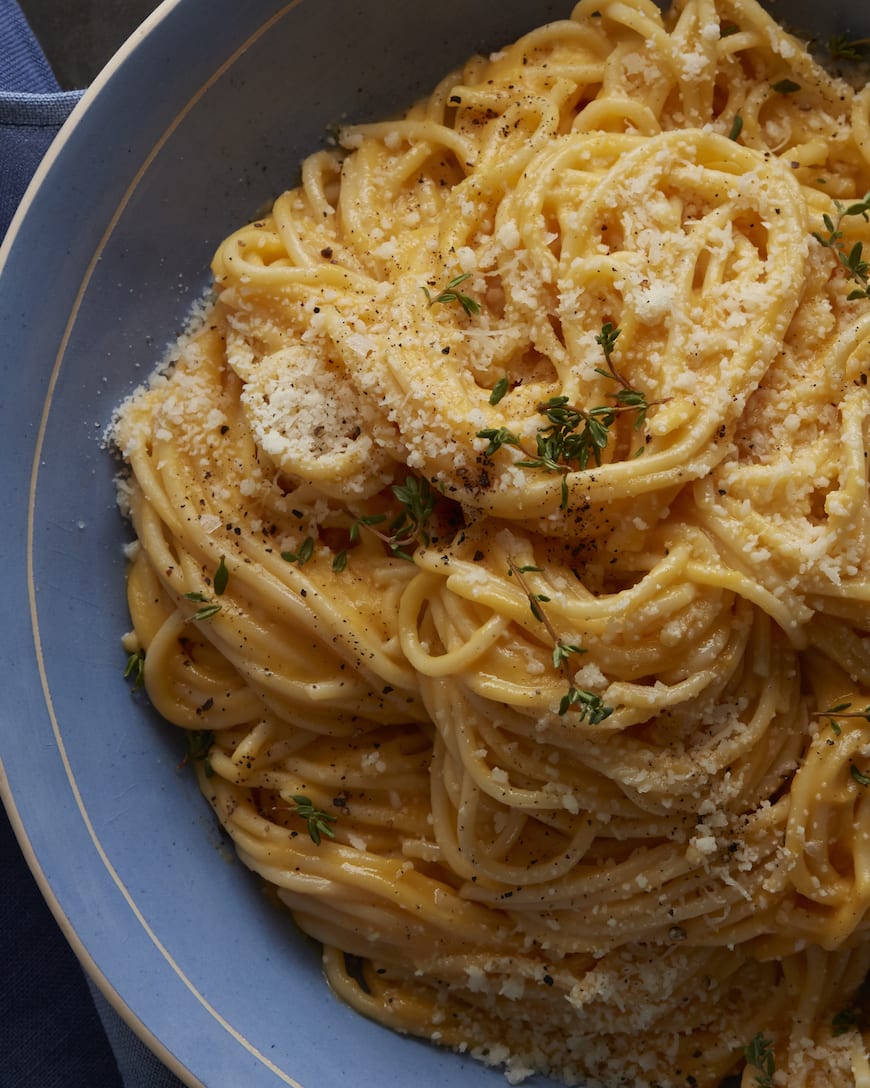
Creamy Butternut Squash Pasta
From What’s Gaby Cooking
This creamy squash pasta is such an easy, comforting vegetarian dinner. If you don’t have shallots on hand, you can substitute the onion from this week’s box. Instead of halving it, chop it into large chunks to roast with the squash and garlic.
Week #21: Darn it, Steve won the bet.
- On: October 06, 2021
 0
0

Top, sweet corn for your CSA boxes,
Middle, transplanting sweet corn seedlings to the field
Bottom, protecting the ears from birds.
I’ve written before to explain our decision to plant more but smaller sweet corn fields this year. Let’s explore more details and share your responses to our sweet corn survey.
Our intention was to increase the number of sweet corn deliveries from five to seven, thereby increasing the odds that we’d deliver corn to all members, regardless of their box schedule. For example, one year we planted five fields but four deliveries fell on one EOW group and the other EOW group only got one delivery. It was just bad luck related to the weather but worth avoiding if we can.
First, we increased the number of plantings but made each field smaller. Then we settled on a favorite variety (‘Vision’) and seeded in flats every 7 to 10 days. This was a dry year, so we were able to transplant the seedlings on a regular schedule but that’s unlikely to work every year. Wet weather can force transplanting delays, throwing off the schedule. Seven weeks is our maximum. Later plantings have too much likelihood of bug damage.
The downside of this new effort is that it creates more work for us; more seedings, more times to gather a transplant crew, more weedings, irrigations, harvests, etc. You get the idea. But we were lucky and it worked well this season.
Wow, you like sweet corn
I sent a short survey to ask how you felt about the new corn schedule. I predicted that you would like getting 8 ears of corn per week, but would be sick of sweet corn by the end of seven weeks. Steve guessed that you wouldn’t (he eats corn every day in season). Darn it, he won the bet! But you won the corn!
Here are your answers. We are very happy with these results.
Comments and Questions
Here are a few of the many comments submitted with the survey. Basically, you either loved the extra corn deliveries or found ways to make them work, eg freezing extras for corn & potato chowder. It’s tough to pick which comment is most endearing, but the first one is an honor.
You gave us some of the best sweet corn we’ve ever had. That’s saying something because we’re both in our 70s and we’ve eaten a lot of sweet corn in our time!
The “sweet corn from the farm” was the only sweet corn that our son would eat!
The number of ears of corn was generally too much for us to eat in one week, but we froze a lot of it, which is just fine with me. Actually I’m thrilled to make some corn chowder later with potatoes…yum! Thank you!
About the caterpillars – I so appreciate when you tell us to just cut the tips off. I follow those instructions and otherwise would find the bugs disturbing and terrible. But when I don’t have to see them, I can pretend they’re not there.
My son and I LOVE, LOVE, LOVE your farm! Our weeks are almost totally based around the CSA! We sit down several times a week to plan and discuss meals, we keep a running inventory, we’re excited about picking it up from our site! Thanks!
To be honest I think you should plant and harvest whichever way is easiest for you. The corn keeps well in the fridge so having a few extra or a few fewer ears per box didn’t make a difference for us.
Brought on by your 5 vs. 7 weeks of corn question: As someone who receives EOW, I wonder why you don’t plan for 6 deliveries? So it doesn’t seem like the other ‘color’ might get an extra week of something depending on timing?
Beth: In a perfect world, six plantings would make sense. We hedge our bets with seven. Don’t worry, we’ll have something special for the other ‘color’.
Maybe we’ve veered into self-congratulation, but it’s fun!
Thanks for taking the survey. I sent the link again in tonight’s email, if anyone still wants to participate.
Beth
.
.
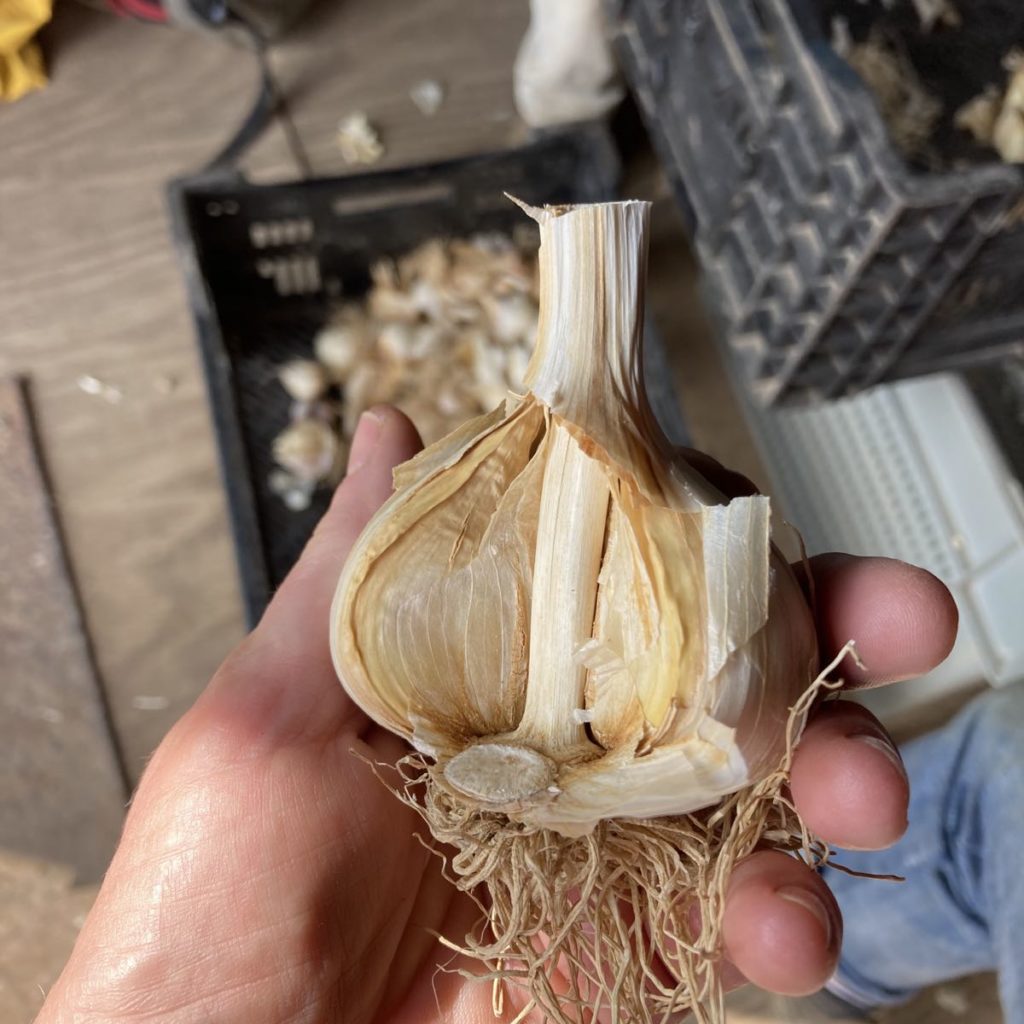
Half garlic bulb this week
Everyone gets a half bulb of garlic this week. These bulbs dried slowly or had bug issues, so we wanted to open and examine each one. Some of them are a little odd but all are useable.
Beth
Veggie List & Veggie Notes
Week #21, October 7/8, 2021
– Weekly shares
– EOW/ purple
– Sampler/ moon
‘Beauregard’ sweet potatoes, ~2 lb
Romano beans, 1.4 lb
Acorn winter squash, 1 small
Carrots, ~2 lb
Colored peppers, 2
Oranos snack peppers, 4 – 5 small
Yellow onion
Red onion
Jalapeno (HOT)
Garlic, one half bulb. Might be a little weird.
Some sites get broccoli (purple &/or green).
Some sites get broccoli & cauliflower.
Next week’s box will probably contain bok choy, butternut squash, scallions, peppers and more.
‘Beauregard’ sweet potatoes – Store your sweet potatoes at room temperature. They suffer chilling injury below 50 F.
Here are a few things we’ve learned about sweet potatoes:
– For best flavor, cook your sweet potatoes so they brown and caramelize. We have a simple, favorite way to roast sweet potatoes. We used to prepare sweet potato fries in the oven. Now we just quarter the potatoes, rub with olive oil, dust with salt and place cut-side-down on a cookie sheet. Roast in a 450 F oven without turning until soft. The flavors will caramelize (like sweet potato fries) but preparation is simpler and the cooking time less exacting. Slender sweet potato fries go from undercooked to overcooked in the blink of an eye. Larger slices are less exacting, and therefore are easier. Small sweet potatoes can be cut just in half. Jumbos will need to be chopped into pieces. Otherwise, they take a long time to cook.
– This first batch of sweet potatoes will need slightly longer cooking than ones from the supermarket, perhaps because they contain higher moisture so soon after harvest.
– Sweet potatoes are good at any size. We have cooked everything from tiny to jumbo and consistently find that all sizes taste good.
Romano beans – Romano beans are more robust and meaty than green beans. They are excellent raw but really shine when gently cooked for a long time. Here’s a pep talk from Tipi member Steve Rankin:
“You have finally sold me. I have never been a fan of Romano beans. This week I have been sautéing them with various peppers and garlic, as well as the oregano from earlier this season. They are especially tasty with poblanos. Lots of black pepper and some soy sauce, which make the pan sticky. I deglaze the pan with wine and braise them in the wine. I’m sold!”
Acorn winter squash – Everyone gets one ‘Jester’ or ‘Carnival’ squash. Store at room temperature for two weeks but keep an eye on your squash and cook promptly if it starts to deteriorate.
Jalapeno chile (HOT) – This small chile is dark green or dark green with a red tip. It’s recognizable by its color and size. It is the only hot pepper this week. All other peppers in this week’s box are sweet.
RECIPES from DEB
Visit our 2020 Recipe Log or our 2019 Recipe Log.
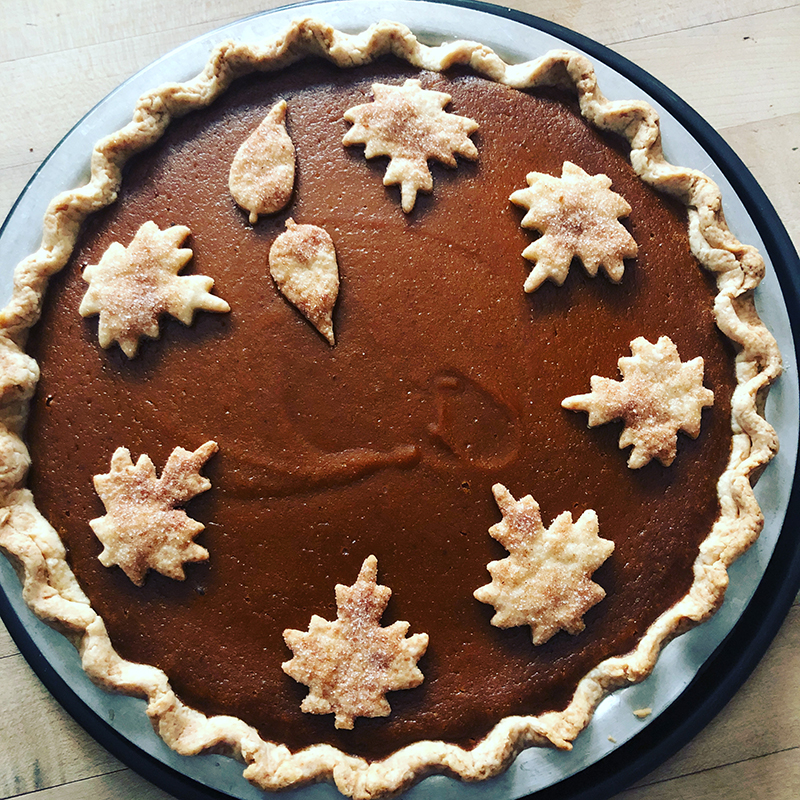
Caramel sweet potato pie
Based on a recipe from November 2018 Food & Wine, this pie could also be made with squash or pumpkin puree.
Takes about 45 minutes active time, plus 30 minutes to chill the crust and 45 minutes to bake.
Makes 8 big slices.
Crust:
1 1/2 cups flour
good pinch salt, unless you’re using salted butter
1 tablespoon sugar
1/2 cup butter, either salted or un- (1 stick, 8 tablespoons)
1 tablespoon vegetable shortening or lard
1 tablespoon sugar
2-4 tablespoons cold water
Special equipment – pie weights or dried beans, parchment paper
Filling:
2 3/4 cups sweet potato puree (roasting the sweet potatoes will give you a drier puree, but steaming also works and is quicker!)
3 large eggs
3/4 cup granulated sugar
3 tablespoons water
2/3 cup heavy cream, warmed
2/3 cup packed dark brown sugar
3 tablespoons unsalted butter
1 teaspoon vanilla extract
a generous pinch of kosher salt
1 1/2 teaspoons ground cinnamon
1/2 teaspoon freshly grated nutmeg
OR use two teaspoons pumpkin pie spice blend, such as Penzey’s
Make the crust: measure the flour, salt and sugar into the bowl of your stand mixer (my favorite method), your food processor, or a mixing bowl. Slice the butter and shortening over the top and combine with the flour mixture, using the paddle attachment of the mixer, by pulsing the processor, or using a pastry blender, 2 knives or your fingers, until you have a crumbly mixture with no butter lumps bigger than currants. With the mixer or processor running, or while stirring with fork, drizzle in the water by tablespoons, until the mixture just starts to come together in clumps. Stop before you have one big ball. Turn the crust out onto a floured surface and knead lightly to bring it together. Gather it into a ball, flatten into a disk, wrap (in plastic, wax paper, one of your reusable snack/sandwich bags), and chill for about 30 minutes, and up to 2 days.
After chilling, roll out the crust and fit it into a deep 9-inch pie plate and trim and crimp the edges. Set it in the freezer or fridge to chill while you make the filling. Cut the trimmings into decorative shapes for the top of your pie, set them on a baking sheet, and chill them, too.
After the crust has chilled, heat the oven to 400°. Line the pie shell with parchment paper, and fill with pie weights or beans. Bake for 16 to 18 minutes. Sprinkle the cutouts with cinnamon sugar, and bake them, too – they’ll brown quickly, so watch carefully! After about 16 minutes, take the shell out, carefully remove paper and weights, and prick the bottom of crust all over with a fork. Return the crust to the oven and bake until bottom is lightly browned, another 4 to 6 minutes. Remove the crust from the oven and let it cool while you make the filling. Reduce the oven temperature to 350°.
Make the filling: Combine the pumpkin puree and the eggs – you’ll get the smoothest filling if you use a food processor, but you can whisk the eggs and potato together in a big bowl, too.
Stir the granulated sugar and 3 tablespoons water together in saucepan much bigger than you think you will need – at least 2 quarts. Cook over medium heat until the sugar melts, about 3 minutes. Increase heat to medium-high and continue cooking, occasionally swirling the saucepan, until mixture is a rich caramel in color, 6 to 7 minutes. Remove from the heat and carefully pour in the warm cream – it will bubble furiously – this is why you need a big pan! Whisk in brown sugar and butter until smooth and incorporated.
When the warm caramel sauce into the pumpkin & egg mixture, and add the vanilla, salt, cinnamon and nutmeg. Pour the filling into the pie shell and smooth the top. Bake until the filling is just set, about 45 minutes. Decorate the top with your crust cutouts while the pie is still warm – they’ll stick better that way.
.
.
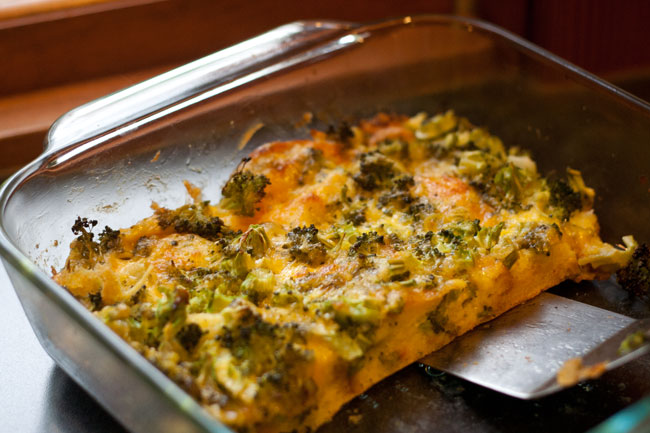
Broccoli Casserole
This is based on Jane & Michael Stern of Roadfood fame, and I got the recipe from the Splendid Table’s How to Eat Supper cookbook. It’s basically a strata, bread, egg, broccoli, and cheese.
Takes about 20 minutes active time, plus an hour to bake.
Serves four generously.
4-6 slices of bread, enough so that torn into bite-sized pieces it will cover the bottom of an 8-in. baking dish. The original recipe calls for soft white bread; I think soft whole wheat is good, too.
3 large eggs
1/4 cup milk
4 tablespoons butter, melted, plus a little extra for greasing the baking dish
1 cup grated cheddar cheese
1 teaspoon salt
1-2 tablespoons sugar (The original recipe calls for three!)
2 cups finely chopped broccoli – I like to do this in the food processor.
Heat the oven to 350°. Butter your baking dish – glass recommended, and cover the bottom of the dish with the torn bread. Beat the eggs, milk, and melted butter together, then add the cheese, salt and sugar. Stir in the broccoli and pour the mixture over the bread. Cover the dish with foil or a lid, and bake for about 45 minutes. Uncover and bake another 10 to 15 minutes to brown the top, and if you want an even crispier top crust, run the casserole under the broiler.
.
.
Miso Vegetables & Tofu Recipe
From 101 Cookbooks
Takes 30 minutes.
Serves 4-6, plus extra miso dressing.
This is a main dish salad with lots of veggies, from the 101 Cookbooks blog. The author, Heidi Swanson, uses asparagus in this version, and says the original recipe, from a book called Everyday Harumi, uses green beans, that we get in the box this week. When I tested this recipe I served it over ramen noodles, and the leftovers were delicious for lunch the next day.
.
.
Garlicky Broccoli Subs
From the Kitchn; by Megan Splawn
Take about 30 minutes.
Serves 4 to 6.
Why can’t broccoli be the star of a sandwich? This recipe from the Kitchn says, “Sure!” Substitute for the peppadews with thin slices of the Oranos peppers from the box, and spice the sandwiches up with some jalapeño if you like.
.
.
Roasted Cauliflower Recipe (Four Ways!)
Kate of Cookie and Kate gives us four different ways to roast cauliflower: Basic, Italian, Mexican, and my personal favorite, with Indian curry spices.
.
.
Adam’s Green Bean Salad
From What’s Gaby Cooking
Takes 20 minutes
Serves 6
This delicious salad can be made with any type of green bean including the Romano beans in this week’s box, as shown in the picture.
.
.
Best Broccoli & Cauliflower Gratin
From Country Living; by Nancy Fuller.
Takes an hour and 10 minutes.
Serves 8-10.
The source of this recipe, County Living Magazine, suggests it as an upgrade for your Thanksgiving side dishes – but I see no reason to wait that long to make it!
.
.
Sweet Potatoes with Tahini Butter Recipe | Bon Appétit
From Bon Appetit; by Carla Lalli Music
Takes about 40 minutes
Serves 6
This recipe for steamed sweet potatoes doused with tahini, butter, and lime juice, by Carla Lalli Music has also appeared in the New York Times, and is the type of recipe that gets a ton of comments – people are passionate about it! Give it a try and see how you feel.

